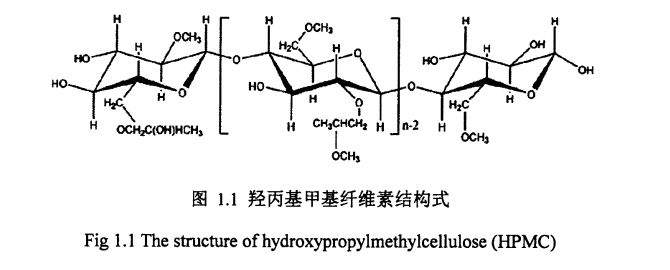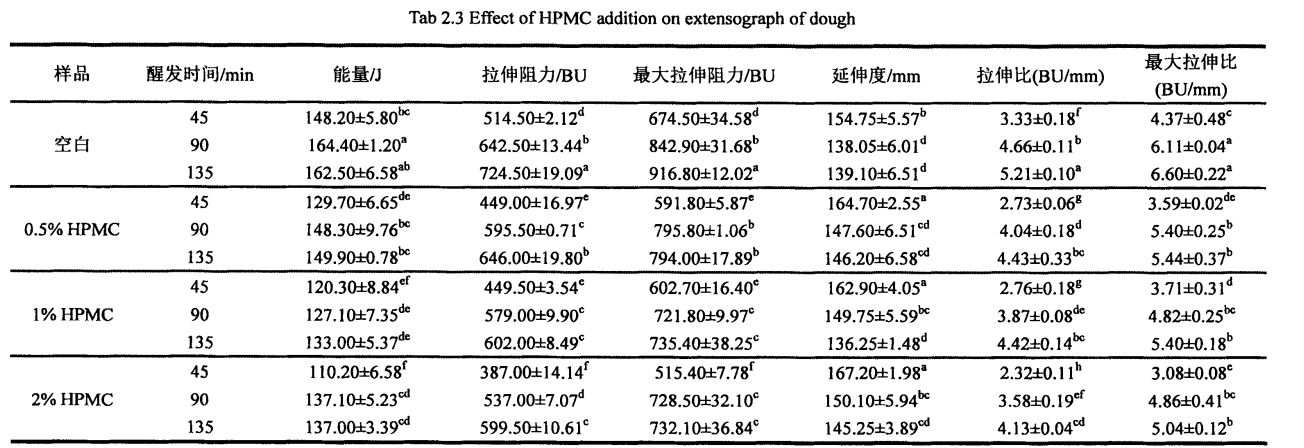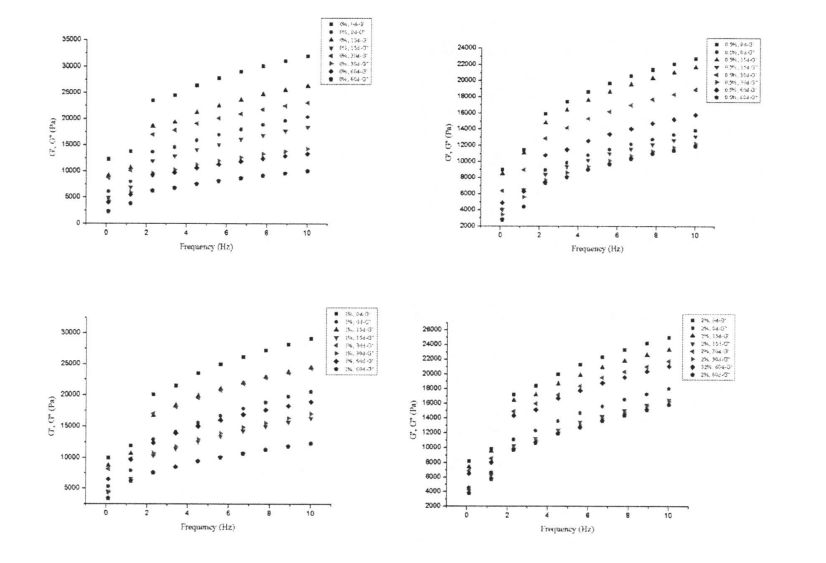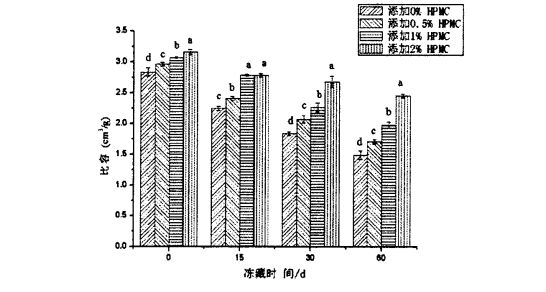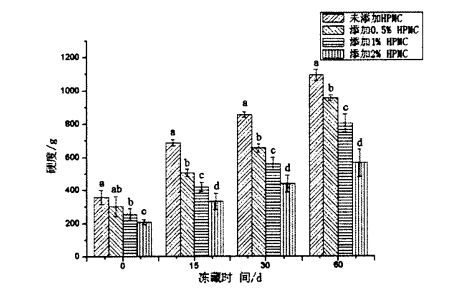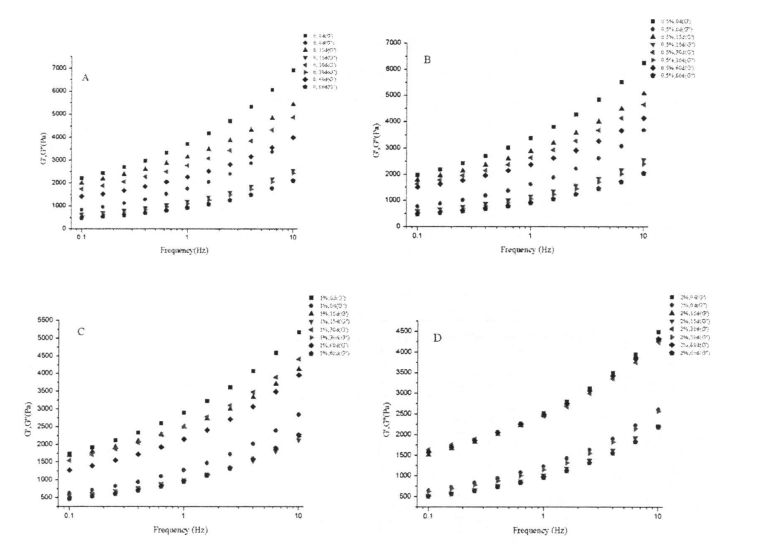Improving the processing properties of frozen dough has certain practical significance for realizing large-scale production of high-quality convenient steamed bread. In this study, a new type of hydrophilic colloid (hydroxypropyl methylcellulose, Yang, MC) was applied to frozen dough. Tika novērtēta 0,5%, 1%, 2%) ietekme uz sasalušās mīklas apstrādes īpašībām un tvaicētās maizes kvalitāte, lai novērtētu HPMC uzlabošanas efektu. Influence on the structure and properties of components (wheat gluten, wheat starch and yeast).
Starch is the most abundant dry matter in dough, and changes in its structure will directly affect the gelatinization characteristics and the quality of the final product. X. The results of X-ray diffraction and DSC showed that the relative crystallinity of starch increased and the gelatinization enthalpy increased after frozen storage. Pagarinot sasaldētu uzglabāšanas laiku, cietes pietūkuma spēks bez HPMC pievienošanas pakāpeniski samazinājās, savukārt cietes želatinizācijas īpašības (maksimālā viskozitāte, minimālā viskozitāte, galīgā viskozitāte, sabrukšanas vērtība un retrogradācijas vērtība) visi ievērojami palielinājās; During the storage time, compared with the control group, with the increase of HPMC addition, the changes of starch crystal structure and gelatinization properties gradually decreased.
Galvenie vārdi: tvaicēta maize; saldēta mīkla; hidroksipropilmetilceluloze; kviešu lipeklis; kviešu ciete; raugs.
Satura rādītājs
1.1. Pašreizējais pētījumu statuss mājās un ārvalstīs ……………………………………………………… l
1.1.2 Research status of steamed buns……………………………………………… . . ………… 1
1.1.7 Hydroxypropyl methyl cellulose (Hydroxypropyl methyl cellulose, I-IPMC) ………. 5
2.2.2. Eksperimentālie instrumenti un aprīkojums ................................................................... 8 8
2.3. Eksperimentālie rezultāti un diskusija ………………………………………………………………….. 11
2.3.1 Kviešu miltu pamatkomponentu indekss ………………………………………………………… .1l
2.3.2. HPMC pievienošanas ietekme uz mīklas farinace īpašībām ………………… .11
2.3.4. HPMC pievienošanas un sasalšanas laika ietekme uz mīklas reoloģiskajām īpašībām …………………………. ………………………………………………………………………………………………………… .15
3.2.3. Eksperimentālie reaģenti …………………………………………………………………………. ………………25
3.2. 25
3.3.2 The effect of adding amount of HPMC and freezing storage time on the freezable moisture content (CFW) and thermal stability……………………………………………………………………. 30
3.3. . 34
3.3.7. HPMC pievienošanas daudzuma un sasalšanas glabāšanas laika ietekme uz glutēna mikro tīkla struktūru ………………………………………………………………………………………………………………………………………………………………………………… .42
3.4. Nodaļas kopsavilkums ............................................................................................... 43 43
4. nodaļa HPMC pievienošanas ietekme uz cietes struktūru un īpašībām sasaldētos uzglabāšanas apstākļos ……………………………………………………………………………………………………………………………………………………………………………………… 44
4.1 Introduction .............................................................................................................................. . 44
4.2. Eksperimentālie materiāli un metodes ..................................................................................................................................................................................................................... 45
4.3 Analysis and discussion ........................................................................................................... 48
4.3.1 Content of basic components of wheat starch ……………………………………………………. 48
4.3.3 Effects of HPMC addition and freezing storage time on the shear viscosity of starch paste………………………………………………………………………………………………………………………………………. 52
4.3.
4.3.
4.3.6 Effects of I-IPMC addition amount and frozen storage time on the thermodynamic properties of starch ………………………………………………………………………………………………………. . 57
4.4. Nodaļas kopsavilkums ................................................................................................................................................................................................................................. 6 1
5. nodaļa HPMC pievienošanas ietekme uz rauga izdzīvošanas līmeni un fermentācijas aktivitāti sasaldētos uzglabāšanas apstākļos ……………………………………………………………………………………………………………………………………………………………………………………………………………………………………………………………………………………………………………………………………………………………………………………………… . 62
5.1Introduction .................................................................................................................................... 62
5.2 Materiāli un metodes ...............................................................................................................................................................................................................................................ut 10. 62
5.2.2 Experimental methods . Apvidū Apvidū . . …………………………………………………………………………. 63
5.3. Rezultāti un diskusija ................................................................................................................................................................................................................................................... NODOKĻI. 64
5.3. "
5.4 Chapter Summary ........................................................................................................................ 67
6. nodaļa Secinājumi un perspektīvas .................................................................................................
6.1. 68
6.2 Outlook .......................................................................................................................................... 68
Ilustrāciju saraksts
1.1. Attēls. Hidroksipropilmetilcelulozes strukturālā formula ………………………. . Ar
Figure 2.4 The effect of HPMC addition and freezing time on the elasticity of steamed bread………………………………………………………………………………………………………………………………. . 20
Figure 3.1 The effect of HPMC addition and freezing time on the rheological properties of wet gluten…………………………………………………………………………………………………………………………. 30
Figure 3.2 Effects of HPMC addition and freezing time on the thermodynamic properties of wheat gluten………………………………………………………………………………………………………………. . 34
3.3. Attēls. HPMC pievienošanas un sasalšanas laika ietekme uz bezmaksas sulfhidrila saturu kviešu glutēnā …………………………………………………………………………………………………………………………………………………………………………………… ...................................... 35
3.4. Attēls. HPMC pievienošanas daudzuma un sasalšanas uzglabāšanas laika ietekme uz slapja glutēna šķērseniskās relaksācijas laika (n) sadalījumu …………………………………………………………………… 36 36
3.5. Attēls. Kviešu glutēna olbaltumvielu infrasarkanā spektra amīda III josla pēc dekonvolūcijas un otrā atvasinājuma montāža …………………………………………………………………… ... 38
3.6. Attēls Ilustrācija ...........................................................................................................................................................................................................................................ut 10. 10. attēls.
3.7. Attēls. HPMC pievienošanas un sasalšanas laika ietekme uz mikroskopiskā lipekļa tīkla struktūru ………………………………………………………………………………………………………… ....................... 43
4.1. Attēls. Cietes želatinizācijas raksturīgā līkne ........................................................... 51
4.2. Attēls. Cietes pastas šķidruma tiksotropija ......................................................................................................................................................................................................................... 52
4.3. Attēls 57
Figure 4.5 Effects of HPMC addition and freezing storage time on the thermodynamic properties of starch…………………………………………………………………………………………………………. . 59
4.6. Attēls. HPMC pievienošanas un sasalšanas glabāšanas laika ietekme uz cietes XRD īpašībām ……………………………………………………………………………………………………………………………………………………………………………………………………… .62
5.1. Attēls. HPMC pievienošanas un sasalšanas laika ietekme uz mīklas pierādīšanas augstumu ……………………………………………………………………………………………………………………………………………………………………………………………… ... 66
5.2. Attēls. HPMC pievienošanas un sasalšanas laika ietekme uz rauga izdzīvošanas ātrumu …………………………………………………………………………………………………………………………………………………………………………………………… ....... ... 67
Figure 5.3 Microscopic observation of yeast (microscopic examination) …………………………………………………………………………………………………………………………. 68
5.4. Attēls. HPMC pievienošanas un sasalšanas laika ietekme uz glutationa (GSH) saturu ……………………………………………………………………………………………………………………………………………………………………………………………… ... 68
Veidlapu saraksts
Table 2.1 The basic ingredient content of wheat flour…………………………………………………. 11
2.4. Tabula. I-IPMC pievienošanas daudzuma un sasalšanas laika ietekme uz sasalušas mīklas sasaldējamu ūdens saturu (CF darbs) ………………………………………………………………………………………………………17 .17
2.5. Tabula. I-IPMC pievienošanas daudzuma un sasalšanas glabāšanas laika ietekme uz tvaicētās maizes tekstūras īpašībām …………………………………………………………………………………………………………………………………………………………………… .21 .21
3.1. Tabula Glutēna pamata sastāvdaļu saturs …………………………………………………………… .25
Table 3.2 Effects of I-IPMC addition amount and freezing storage time on the phase transition enthalpy (Yi IV) and freezer water content (e chat) of wet gluten………………………. 31
Table 3.3 Effects of HPMC addition amount and freezing storage time on the peak temperature (product) of thermal denaturation of wheat gluten…………………………………………. 33
3.4. Tabula Olbaltumvielu sekundāro struktūru maksimālās pozīcijas un to uzdevumi ………… .37
3.5. Tabula. HPMC pievienošanas un sasalšanas laika ietekme uz kviešu glutēna sekundāro struktūru ………………………………………………………………………………………………………………………………………………………………………………………………… .40
Table 3.6 Effects of I-IPMC addition and freezing storage time on the surface hydrophobicity of wheat gluten……………………………………………………………………………………………. 41
4.3. Tabula. I-IPMC pievienošanas un sasalšanas laika ietekme uz kviešu cietes pastas bīdes viskozitāti …………………………………………………………………………………………………………………………………………………………………………………………… 55
1. nodaļa Priekšvārds
1.1.2. Izmeklēšanas tvaicētas maizes statuss
Pašlaik tvaicētās maizes pētījums galvenokārt ir vērsts uz šādiem aspektiem:
1) Jaunu raksturīgu tvaicētu maizīšu izstrāde. Through the innovation of steamed bread raw materials and the addition of functional active substances, new varieties of steamed breads have been developed, which have both nutrition and function. Established the evaluation standard for the quality of miscellaneous grain steamed bread by principal component analysis; Fu et a1. (2015) added lemon pomace containing dietary fiber and polyphenols to steamed bread, and evaluated the antioxidant activity of steamed bread; Hao & Beta (2012) studied barley bran and flaxseed (rich in bioactive substances) The production process of steamed bread [5]; Shiau et a1. (2015) evaluated the effect of adding pineapple pulp fiber on dough rheological properties and steamed bread quality [6].
2)Research on the processing and compounding of special flour for steamed bread. The effect of flour properties on the quality of dough and steamed buns and the research on new special flour for steamed buns, and based on this, an evaluation model of flour processing suitability was established [7]; Piemēram, dažādu miltu malšanas metožu ietekme uz miltu un tvaicētu maizīšu kvalitāti [7] 81; Vairāku vaskotu kviešu miltu salikšanas ietekme uz tvaicētās maizes kvalitāti [9j et al.; Zhu, Huang, &Khan (2001) evaluated the effect of wheat protein on the quality of dough and northern steamed bread, and considered that gliadin/ Glutenin was significantly negatively correlated with dough properties and steamed bread quality [lo]; Džan, et a1. (2007) analyzed the correlation between gluten protein content, protein type, dough properties and steamed bread quality, and concluded that the content of high molecular weight glutenin subunit (1ligh.molecular-weight, HMW) and total protein content are all related to the quality of northern steamed bread. ir būtiska ietekme [11].
4)Research on quality improvement of steamed bread. Research on the addition and application of steamed bread quality improvers; Galvenokārt iekļaujot piedevas (piemēram, fermentus, emulgatorus, antioksidantus utt.) Un citus eksogēnus proteīnus [14], cieti un modificētu cieti [15] utt. Atbilstošā procesa pievienošana un optimizācija ir īpaši ievērības cienīga, ka pēdējos gados, izmantojot dažus eksogēnus, kas ir saistīti ar diētu (bez glutuļu, izmantojot. needs of patients with Coeliac Disease [16.1 cit.
5)Preservation and anti-aging of steamed bread and related mechanisms. Pan Lijun et al. (2010) optimized the composite modifier with good anti-aging effect through experimental design [l do not; Wang, et a1. (2015) pētīja lipekļa olbaltumvielu polimerizācijas pakāpes, mitruma un cietes pārkristalizācijas ietekmi uz tvaicētas maizes cietības palielināšanos, analizējot tvaicētas maizes fizikālās un ķīmiskās īpašības. The results showed that water loss and starch recrystallization were the main reasons for the aging of steamed bread [20].
6)Research on the application of new fermented bacteria and sourdough. Jiang, et a1. (2010) Chaetomium sp. fermented to produce xylanase (with thermostable) in steamed bread [2l'; Gerez, et a1. (2012) used two kinds of lactic acid bacteria in fermented flour products and evaluated their quality [221; Wu, et al. (2012) studied the influence of sourdough fermented by four kinds of lactic acid bacteria (Lactobacillus plantarum, Lactobacillus, sanfranciscemis , Lactobacillus brevis and Lactobacillus delbrueckii subsp bulgaricus) on the quality (specific volume, texture, fermentation flavor, etc.) of northern steamed bread [23]; un Gerezs, et a1. (2012) used the fermentation characteristics of two kinds of lactic acid bacteria to accelerate the hydrolysis of gliadin to reduce the allergenicity of flour products [24] and other aspects.
Among them, steamed bread is prone to aging under conventional storage conditions, which is an important factor restricting the development of steamed bread production and processing industrialization. Pēc novecošanās tiek samazināta tvaicētās maizes kvalitāte - tekstūra kļūst sausa un cieta, dregs, sarūk un plaisas, sensoro kvalitāte un aromāts pasliktinās, samazinās gremošanas un absorbcijas ātrums un samazinās uzturvērtība. This not only affects its shelf life, but also creates a lot of waste. According to statistics, the annual loss due to aging is 3% of the output of flour products. 7%. With the improvement of people's living standards and health awareness, as well as the rapid development of the food industry, how to industrialize the traditional popular staple noodle products including steamed bread, and obtain products with high quality, long shelf life and easy preservation to meet the needs of the growing demand for fresh, safe, high-quality and convenient food is a long-standing technical problem. Based on this background, frozen dough came into being, and its development is still in the ascendant.
1.1.3. Ievads līdz saldētai mīklai
Frozen dough is a new technology for the processing and production of flour products developed in the 1950s. Tas galvenokārt attiecas uz kviešu miltu izmantošanu kā galveno izejvielu un ūdeni vai cukuru kā galvenos palīgmateriālus. Cepts, iesaiņots vai iesaiņots, ātrs sasaldēšana un citi procesi liek produktam sasniegt saldētu stāvokli, un, lai izstrādātos produktus sasaldētu 18 "C, galaproduktam jābūt atkausētam, jāpierāda, vārīti utt. [251].
Saskaņā ar ražošanas procesu sasaldētu mīklu var aptuveni sadalīt četros veidos.
Deviņdesmitajos gados Ķīnā tika ieviesta saldēta mīklas pārstrādes tehnoloģija. With the continuous development of science and technology and the continuous improvement of people's living standards, frozen dough technology has broad development prospects and huge development space
Saldētā mīklas tehnoloģija neapšaubāmi sniedz realizējamu ideju par tradicionālās ķīniešu ēdienu, piemēram, tvaicētas maizes, rūpnieciski attīstītu ideju. However, this processing technology still has some shortcomings, especially under the condition of longer freezing time, the final product will have longer proofing time, lower specific volume, higher hardness, Water loss, poor taste, reduced flavor, and quality deterioration. Turklāt sasalšanas dēļ
a) Kā ierobežot saldētās mīklas kvalitāti pasliktināšanās ar sasalušā uzglabāšanas laika pagarinājumu, it īpaši kā kontrolēt ledus kristālu veidošanās un augšanas ietekmi uz trīs galveno mīklas komponentu (cietes, glutēna un rauga) struktūru un īpašībām) joprojām ir jautājums. Karsto punktu un pamatjautājumi šajā pētniecības jomā;
c) paplašināt, optimizēt un izmantot jaunus saldētas mīklas kvalitātes uzlabotājus, kas veicina ražošanas uzņēmumu optimizāciju un produktu veidu inovācijas un izmaksu kontroli. At present, it still needs to be further strengthened and expanded;
d) Hidrokoloīdu ietekme uz sasalušo mīklas produktu kvalitātes uzlabošanos un ar to saistītajiem mehānismiem joprojām ir jāpēta un sistemātiski jāpaskaidro.
Ņemot vērā iepriekšminētās sasalušās mīklas problēmas un izaicinājumus, ilgtermiņa novatoriskus pētījumus par sasalušas mīklas tehnoloģijas pielietojumu, sasaldētu mīklas produktu kvalitātes kontroli un uzlabošanu un ar to saistīto mehānismu, kas saistīta ar materiālu komponentu izmaiņu un īpašību īpašībām sasaldēto mīklu sistēmā un kvalitātes pasliktināšanā, šāds pētījums ir karsts jautājums, kas beidzas ar mīklas pētījumu pēdējos gados. Konkrēti, galvenie vietējie un ārvalstu pētījumi pēdējos gados galvenokārt koncentrējas uz šādiem punktiem:
I. Saskaņā ar saldētās mīklas struktūras un īpašību izmaiņām ar sasalšanas glabāšanas laika pagarinājumu, lai izpētītu produkta kvalitātes pasliktināšanās iemeslus, jo īpaši ledus kristalizācijas ietekmi uz bioloģiskajām makromolekulām (olbaltumvielām, cieti utt.), Piemēram, ledus kristalizācija. Formation and growth and its relationship with water state and distribution; changes in wheat gluten protein structure, conformation and properties [31]; cietes struktūras un īpašību izmaiņas; changes in dough microstructure and related properties, etc. 361.
Pētījumi liecina, ka galvenie iesaldētās mīklas apstrādes īpašību pasliktināšanās iemesli ir: 1) sasalšanas procesa laikā rauga izdzīvošana un tā fermentācijas aktivitāte ir ievērojami samazināta; 2) The continuous and complete network structure of the dough is destroyed, resulting in the air holding capacity of the dough. and the structural strength is greatly reduced.
II. Optimization of frozen dough production process, frozen storage conditions and formula. During the production of frozen dough, temperature control, proofing conditions, pre-freezing treatment, freezing rate, freezing conditions, moisture content, gluten protein content, and thawing methods will all affect the processing properties of frozen dough [37]. In general, higher freezing rates produce ice crystals that are smaller in size and more uniformly distributed, while lower freezing rates produce larger ice crystals that are not uniformly distributed. In addition, a lower freezing temperature even below the glass transition temperature (CTA) can effectively maintain its quality, but the cost is higher, and the actual production and cold chain transportation temperatures are usually small. In addition, the fluctuation of the freezing temperature will cause recrystallization, which will affect the quality of the dough.
III. Piedevu izmantošana, lai uzlabotu saldētas mīklas produktu kvalitāti. In order to improve the product quality of frozen dough, many researchers have made explorations from different perspectives, for example, improving the low temperature tolerance of material components in frozen dough, using additives to maintain the stability of the dough network structure [45.56], etc. Among them, the use of additives is an effective and widely used method. Galvenokārt ietilpst, i) enzīmu preparāti, piemēram, transglutamināze, o [. Amilāze; ii) emulgatori, piemēram, monoglicerīdu stearāts, Datem, SSL, CSL, Datem utt.; iii) antioksidanti, askorbīnskābe utt.; iv) polisaharīdu hidrokoloīdi, piemēram, guāra sveķis, dzeltenā oriģināls, gumijas arābu valoda, Konjac gumija, nātrija algināts utt.; v) citas funkcionālās vielas, piemēram, Xu, et a1. (2009) added Ice-structuring Proteins to wet gluten mass under freezing conditions, and studied its protective effect and mechanism on the structure and function of gluten protein [y71.
Ⅳ. Breeding of antifreeze yeast and application of new yeast antifreeze [58-59]. Sasano, et a1. (2013), hibridizācijas un rekombinācijas starp dažādiem celmiem [60–61], ieguva sasaldēšanas tolerantus celmus, un S11i, Yu, & Lee (2013) pētīja biogēno ledus kodolu kodolieroču, kas iegūts no Erwinia herbikiem, ko izmanto, lai aizsargātu rauga rauga stāvokli sasaldēšanas apstākļos [62J.
1.1.6
The chemical nature of hydrocolloid is a polysaccharide, which is composed of monosaccharides (glucose, rhamnose, arabinose, mannose, etc.) through 0 [. 1-4. Glycosidic bond or/and a. 1--"6. Glycosidic bond or B. 1-4. Glycosidic bond and 0 [.1-3. The high molecular organic compound formed by the condensation of glycosidic bond has a rich variety and can be roughly divided into: ① Cellulose derivatives , such as methyl cellulose (MC), carboxymethyl cellulose (CMC); ② plant polysaccharides, such as konjac gum, guar gum, gum Arabic ; ③ seaweed polysaccharides, such as seaweed gum, carrageenan; ④ microbial polysaccharides, such as Xanthan gum .Polysaccharide has strong hydrophilicity because it contains a large number of hydroxyl groups that are easy to form hydrogen bonds with water, and has the functions of controlling the migration, state and distribution of water in the food system. Therefore, the addition of hydrophilic colloids gives food Many functions, properties, and qualities of hydrocolloids are closely related to the interaction between polysaccharides and water and other macromolecular substances. At the same time, due to the multiple functions of thickening, stabilizing, and water retention, hydrocolloids are widely used to include in the food processing of flour products. Wang Xin et al. (2007) pētīja jūras aļģu polisaharīdu un želatīna pievienošanas ietekmi uz mīklas stikla pārejas temperatūru [631. Wang Yusheng et al. (2013) believed that compound addition of a variety of hydrophilic colloids can significantly change the flow of dough. Change the properties, improve the tensile strength of the dough, enhance the elasticity of the dough, but reduce the extensibility of the dough [delete.
Due to the existence of hydrogen bonds in the linear molecular chain and crystalline structure, cellulose has poor water solubility, which also limits its application range. Tomēr aizvietotāju klātbūtne HPMC sānu ķēdē sabojā intramolekulārās ūdeņraža saites, padarot to hidrofilāku [66L], kas var ātri uzbriest ūdenī un veidot stabilu biezu koloidālu izkliedi zemā temperatūras kaklasaitē. Kā celulozes atvasinājumu bāzes hidrofīlais koloīds, HPMC ir plaši izmantots materiālu, papīra veidošanas, tekstilizstrādājumu, kosmētikas, farmaceitisko līdzekļu un pārtikas laukos [6 71]. In particular, due to its unique reversible thermo-gelling properties, HPMC is often used as a capsule component for controlled release drugs; in food, HPMC is also used as a surfactant, Thickeners, emulsifiers, stabilizers, etc., and play a role in improving the quality of related products and realizing specific functions. For example, the addition of HPMC can change the gelatinization characteristics of starch and reduce the gel strength of starch paste. , HPMC can reduce the loss of moisture in food, reduce the hardness of bread core, and effectively inhibit the aging of bread.
Although HPMC has been used in pasta to a certain extent, it is mainly used as an anti-aging agent and water-retaining agent for bread, etc., which can improve product specific volume, texture properties and prolong shelf life [71.74]. Tomēr, salīdzinot ar hidrofīliem koloīdiem, piemēram, guāra smaganu, ksantāna gumiju un nātrija alginātu [75-771], nav daudz pētījumu par HPMC lietošanu saldētā mīklā, neatkarīgi no tā, vai tā var uzlabot tvaicētas maizes kvalitāti, kas apstrādāta no saldētas mīklas. There is still a lack of relevant reports on its effect.
Pašlaik attīstības stadijā joprojām ir sasalušas mīklas pārstrādes tehnoloģijas pielietojums un liela mēroga ražošana manā valstī kopumā. Tajā pašā laikā pašā iesaldētajā mīklā ir zināmas nepilnības un trūkumi. These comprehensive factors undoubtedly restrict the further application and promotion of frozen dough. on the other hand,this also means that the application of frozen dough has great potential and broad prospects, especially from the perspective of combining frozen dough technology with the industrialized production of traditional Chinese noodles (non-)fermented staple food, to develop more products that meet the needs of Chinese residents. It is of practical significance to improve the quality of the frozen dough based on the characteristics of Chinese pastry and the dietary habits, and is suitable for the processing characteristics of Chinese pastry.
Tieši tāpēc, ka attiecīgie HPMC lietojumprogrammas pētījumi ķīniešu nūdelēs joprojām trūkst. Therefore, the purpose of this experiment is to expand the application of HPMC to frozen dough, and to determine the improvement of frozen dough processing by HPMC through the evaluation of steamed bread quality. In addition, HPMC was added to the three main components of the dough (wheat protein, starch and yeast liquid), and the effect of HPMC on the structure and properties of wheat protein, starch and yeast was systematically studied. And explain its related mechanism problems, in order to provide a new feasible path for the quality improvement of frozen dough, so as to expand the application scope of HPMC in the food field, and to provide theoretical support for the actual production of frozen dough suitable for making steamed bread.
1.3 Galvenais pētījuma saturs
Effects of addition amount and frozen storage time on the structure and properties of frozen dough, the quality of frozen dough products (steamed bread), the structure and properties of wheat gluten, the structure and properties of wheat starch, and the fermentation activity of yeast. Balstoties uz iepriekšminētajiem apsvērumiem, šajā pētījuma tēmā tika veikts šāds eksperimentāls dizains:
1)Select a new type of hydrophilic colloid, hydroxypropyl methylcellulose (HPMC) as an additive, and study the addition amount of HPMC under different freezing time (0, 15, 30, 60 days; the same below) conditions. (0%, 0,5%, 1%, 2%; tas pats zemāk) par sasaldētas mīklas reoloģiskajām īpašībām un mikrostruktūru, kā arī par mīklas izstrādājuma kvalitāti - tvaicētu maizi (ieskaitot tvaicētās maizes tvaicēto tvaicēto tilpumu), pēta hpmc pievienošanas un novērtētās maizes uzlabošanas uzlabojumu. on the processing properties of the frozen dough;
4) No uzlabošanas mehānisma viedokļa tika pētīta dažādu HPMC papildinājumu ietekme uz fermentācijas aktivitāti, izdzīvošanas ātrumu un ārpusšūnu glutationa saturu dažādos sasalšanas glabāšanas laika apstākļos.
Vispārīgi runājot, mīklas materiāla sastāvs, ko izmanto raudzētu miltu produktu izgatavošanai, galvenokārt ietver bioloģiskas makromolekulāras vielas (cieti, olbaltumvielas), neorganisku ūdeni un organismu raugu, un tas veidojas pēc hidratācijas, šķērssavienojuma un mijiedarbības. A stable and complex material system with a special structure has been developed. Numerous studies have shown that the properties of the dough have a significant impact on the quality of the final product. Therefore, by optimizing the compounding to meet the specific product and it is a research direction to improve the dough formulation and technology of the quality of the product or food for use; on the other hand, improving or improving the properties of dough processing and preservation to ensure or improve the quality of the product is also an important research issue.
Tāpēc šis eksperimentālais dizains galvenokārt tiek veikts no diviem aspektiem: HPMC pievienošanas ietekme uz sasalušās mīklas sistēmas īpašībām un ietekmi uz tvaicētu maizes izstrādājumu kvalitāti.
2.2 Eksperimentālie materiāli un metodes
2.2.1 Eksperimentālie materiāli
Zhongyu Wheat Flour Binzhou Zhongyu Food Co., Ltd.; Eņģeļa aktīvā sausā rauga eņģeļu rauga Co., Ltd.; HPMC (methyl substitution degree of 28%.30%, hydroxypropyl substitution degree of 7%.12%) Aladdin (Shanghai) Chemical Reagent Company; all chemical reagents used in this experiment are of analytical grade;
Instrumenta un aprīkojuma nosaukums
Ta-CTS plus fiziskā īpašuma testeris
Sm. 986S dough mixer
C21. KT2134 indukcijas plīts
Powder meter. E
Extensometer. E
Discovery R3 Rotācijas reometrs
Kjeltee TM 8400 automātiskais Kjeldahl slāpekļa analizators
Ražotājs
Stab Micro Systems, Lielbritānija
Top Virtuves ierīču tehnoloģija Co., Ltd.
Guangdong Midea Life Appliance Manufacturing Co., Ltd.
Huang Shi Heng Feng Medical Equipment Co., Ltd.
2.2.3 Eksperimentālā metode
Saskaņā ar GB 50093.2010, GB 5009.5–2010, GB/T 5009.9.2008, GB50094.2010t78-81], nosakiet kviešu miltu pamatkomponentus-mitrumu, olbaltumvielas, cietes un pelnu saturu.
2.2.3.2.
Saskaņā ar atsauces metodi GB/T 14614.2006 Mīklas farinaceous īpašību noteikšana [821.
Mīklas stiepes īpašību noteikšana saskaņā ar GB/T 14615.2006 [831.
2.2.3.4. Saldētas mīklas ražošana
Refer to the dough making process of GB/T 17320.1998 [84]. Weigh 450 g of flour and 5 g of active dry yeast into the bowl of the dough mixer, stir at low speed to fully mix the two, and then add 245 mL of low-temperature (Distilled water (pre-stored in the refrigerator at 4°C for 24 hours to inhibit the activity of yeast), first stir at low speed for 1 min, then at medium speed for 4 min until dough is formed. Take out the dough and divide it into about 180g / portion, knead it into a cylindrical shape, then seal it with a ziplock bag, and put it in. Freeze at 18°C for 15, 30, and 60 days. Add 0.5%, 1%, 2% (w/w, dry basis) HPMC to replace the corresponding proportion of flour quality to make dough, and the rest of the production methods remain unchanged. The 0-day frozen storage (unfrozen storage) was used as the control Eksperimentālā grupa.
Take out the dough samples after the corresponding freezing time, put them in a refrigerator at 4 °C for 4 h, and then place them at room temperature until the dough samples are completely melted. Parauga apstrādes metode ir piemērojama arī 2.3.6. Eksperimentālajai daļai.
A sample (about 2 g) of the central part of the partially melted dough was cut and placed on the bottom plate of the rheometer (Discovery R3). Pirmkārt, paraugs tika pakļauts dinamiskai celma skenēšanai. The specific experimental parameters were set as follows: A parallel plate with a diameter of 40 mm was used, the gap was set to 1000 mln, the temperature was 25 °C, and the scanning range was 0.01%. 100%, the sample rest time is 10 min, and the frequency is set to 1Hz. The Linear Viscoelasticity Region (LVR) of the tested samples was determined by strain scanning. Then, the sample was subjected to a dynamic frequency sweep, and the specific parameters were set as follows: the strain value was 0.5% (in the LVR range), the resting time, the fixture used, the spacing, and the temperature were all consistent with the strain sweep parameter settings. Five data points (plots) were recorded in the rheology curve for each 10-fold increase in frequency (linear mode). After each clamp depression, the excess sample was gently scraped with a blade, and a layer of paraffin oil was applied to the edge of the sample to prevent water loss during the experiment. Katru paraugu atkārtoja trīs reizes.
2.2.3.6
Among them, 厶 represents the latent heat of moisture, and its value is 334 J Dan; MC (total Moisture Content) represents the total moisture content in the dough (measured according to GB 50093.2010t78]). Katru paraugu atkārtoja trīs reizes.
2.2.3.7. Tvaicēta maizes ražošana
Pēc atbilstošā sasalšanas laika sasaldēto mīklu izņēma, vispirms 4 stundas līdzsvaroja 4 ° C ledusskapī un pēc tam novietoja istabas temperatūrā, līdz saldētā mīkla bija pilnībā atkausēta. Sadaliet mīklu apmēram 70 gramos vienā porcijā, mīciet to formā un pēc tam ielieciet nemainīgā temperatūras un mitruma kastē un pierādiet to 60 minūtes 30 ° C temperatūrā un relatīvā mitruma 85%. After proofing, steam for 20 min, and then cool for 1 h at room temperature to evaluate the quality of steamed bread.
2.2.3.8. Tvaicētas maizes kvalitātes novērtējums
Saskaņā ar GB/T 20981.2007. [871, tika izmantota rapšu pārvietošanas metode, lai izmērītu tvaicēto bulciņu daudzumu (darbu), un tvaicēto bulciņu masa (m) tika izmērīta, izmantojot elektronisko līdzsvaru. Each sample was replicated three times.
(2) Tvaicētas maizes kodola faktūras īpašību noteikšana
Skatiet SIM metodi, Noor Aziah, Cheng (2011) [88] ar nelielām modifikācijām. No tvaicētās maizes centrālā apgabala tika sagriezts tvaicētas maizes 20x 20 x 20 mn'13, un tvaicētās maizes TPA (tekstūras profila analīze) tika izmērīts ar fiziskā īpašuma testeri. Specific parameters: the probe is P/100, the pre-measurement rate is 1 mm/s, the mid-measurement rate is 1 mm/s, the post-measurement rate is 1 mm/s, the compression deformation variable is 50%, and the time interval between two compressions is 30 S, the trigger force is 5 g. Each sample was repeated 6 times.
2.2.3.9 Datu apstrāde
2.3 Eksperimentālie rezultāti un diskusija
2.3.1 Kviešu miltu pamata sastāva indekss
2.3.2. I-IPMC pievienošanas ietekme uz mīklas farinace īpašībām
As shown in Table 2.2, with the increase of HPMC addition, the water absorption of dough increased significantly, from 58.10% (without adding HPMC dough) to 60.60% (adding 2% HPMC dough). Turklāt HPMC pievienošana uzlaboja mīklas stabilitātes laiku no 10,2 minūtēm (tukša) līdz 12,2 minūtēm (pievienots 2% HPMC). Tomēr, palielinoties HPMC pievienošanai, gan mīklas veidošanās laiks, gan mīklas vājināšanās pakāpe ievērojami samazinājās, salīdzinot ar tukšo mīklu, veidojot laiku 2,10 minūtes, un vājinošā pakāpe 55,0 FU attiecīgi, pievienojot 2% HPMC, mīklas veidošanās laiks bija 1 .50 minūtes un vājāka 18,0 fu, samazinot 28,57% un 67,27%.
Because HPMC has strong water retention and water holding capacity, and is more absorbent than wheat starch and wheat gluten [8"01, therefore, the addition of HPMC improves the water absorption rate of the dough. The dough forming time is when the dough consistency reaches 500 The time required for FU, the addition of HPMC reduces the dough formation time, which indicates that the addition of HPMC promotes the formation of the dough. The dough stability time is the time when the dough consistency is maintained above 500 FU, and HPMC increases the dough stability time, which is due to the dough It is caused by the shortening of the forming time and the relative stability of the dough consistency. The degree of weakening represents the difference between the maximum consistency of the dough and the final consistency, and the reduction of the weakening degree of the dough by HPMC shows that HPMC var būt loma mīklas konsekvences stabilizēšanā.
2.3.3. HPMC pievienošanas ietekme uz mīklas stiepes īpašībām
Mīklas stiepes īpašības var labāk atspoguļot mīklas apstrādes īpašības pēc pierādīšanas, ieskaitot mīklas paplašināmību, stiepes pretestību un stiepšanās attiecību. The tensile properties of the dough are attributed to the extension of the glutenin molecules in the dough extensibility, as the cross-linking of glutenin molecular chains determines the elasticity of the dough [921]. Termonia, Smith (1987) [93] believed that the elongation of polymers depends on two chemical kinetic processes, that is, the breaking of secondary bonds between molecular chains and the deformation of cross-linked molecular chains. Ja molekulārās ķēdes deformācijas ātrums ir salīdzinoši zems, molekulārā ķēde nevar pietiekami un ātri tikt galā ar stresu, ko rada molekulārās ķēdes stiepšanās, kas savukārt noved pie molekulārās ķēdes sadalīšanās, kā arī molekulārās ķēdes pagarinājuma garums ir arī īss. Tikai tad, kad molekulārās ķēdes deformācijas ātrums var nodrošināt, ka molekulāro ķēdi var ātri un pietiekami deformēt, un kovalentie saites mezgli molekulārajā ķēdē netiks salauzti, polimēra pagarinājumu var palielināt. Tāpēc lipekļa olbaltumvielu ķēdes deformācijas un pagarinājuma izturēšanās mainīšana ietekmēs mīklas stiepes īpašības [92].
Table 2.3 lists the effects of different amounts of HPMC (O, 0.5%, 1% and 2%) and different proofing 1'9 (45 min, 90 min and 135 min) on the dough tensile properties (energy, stretch resistance, maximum stretch resistance, elongation, stretch ratio and maximum stretch ratio). The experimental results show that the tensile properties of all dough samples increase with the extension of the proofing time except the elongation which decreases with the extension of the proofing time. For the energy value, from 0 to 90 min, the energy value of the rest of the dough samples increased gradually except for the addition of 1% HPMC, and the energy value of all dough samples increased gradually. There were no significant changes. This shows that when the proofing time is 90 min, the network structure of the dough (cross-linking between molecular chains) is completely formed. Tāpēc pierādīšanas laiks tiek pagarināts vēl vairāk, un enerģijas vērtībā nav būtiskas atšķirības. Tajā pašā laikā tas var arī sniegt atsauci mīklas pierādīšanas laika noteikšanai. As the proofing time prolongs, more secondary bonds between molecular chains are formed and the molecular chains are more closely cross-linked, so the tensile resistance and the maximum tensile resistance increase gradually. At the same time, the deformation rate of molecular chains also decreased with the increase of secondary bonds between molecular chains and the tighter cross-linking of molecular chains, which led to the decrease of the elongation of the dough with the excessive extension of the proofing time. The increase in tensile resistance/maximum tensile resistance and the decrease in elongation resulted in an increase in tensile LL/maximum tensile ratio.
Tomēr HPMC pievienošana var efektīvi nomākt iepriekš minēto tendenci un mainīt mīklas stiepes īpašības. With the increase of HPMC addition, the tensile resistance, maximum tensile resistance and energy value of the dough all decreased correspondingly, while the elongation increased. Specifically, when the proofing time was 45 min, with the increase of HPMC addition, the dough energy value decreased significantly, from 148.20-J: 5.80 J (blank) to 129.70-J respectively: 6.65 J (add 0.5% HPMC), 120.30 ± 8.84 J (add 1% HPMC), and 110.20-a: 6.58
J (2% HPMC added). At the same time, the maximum tensile resistance of the dough decreased from 674.50-a: 34.58 BU (blank) to 591.80--a: 5.87 BU (adding 0.5% HPMC), 602.70± 16.40 BU (1% HPMC added), and 515.40-a: 7.78 BU (2% HPMC added). However, the elongation of the dough increased from 154.75+7.57 MITI (blank) to 164.70-a: 2.55 m/rl(adding 0.5% HPMC), 162.90-a: 4 .05 min (1% HPMC added), and 1 67.20-a: 1.98 min (2% HPMC added). This may be due to the increase of the plasticizer-water content by adding HPMC, which reduces the resistance to the deformation of the gluten protein molecular chain, or the interaction between HPMC and the gluten protein molecular chain changes its stretching behavior, which in turn affects It improves the tensile properties of the dough and increases the extensibility of the dough, which will affect the quality (eg, specific volume, texture) galaprodukta.
2.3.4. HPMC pievienošanas daudzuma un sasalšanas uzglabāšanas laika ietekme uz mīklas reoloģiskajām īpašībām
Mīklas reoloģiskās īpašības ir svarīgs mīklas īpašību aspekts, kas var sistemātiski atspoguļot visaptverošās mīklas īpašības, piemēram, viskoelastību, stabilitāti un apstrādes īpašības, kā arī izmaiņas īpašībās apstrādes un uzglabāšanas laikā.
Figure 2.1 shows the change of storage modulus (elastic modulus, G') and loss modulus (viscous modulus, G") of dough with different HPMC content from 0 days to 60 days. The results showed that with the prolongation of freezing storage time, the G' of the dough without adding HPMC decreased significantly, while the change of G" was relatively small, and the /an Q (G''/G') increased. This may be due to the fact that the network structure of the dough is damaged by ice crystals during freezing storage, which reduces its structural strength and thus the elastic modulus decreases significantly. However, with the increase of HPMC addition, the variation of G' gradually decreased. In particular, when the added amount of HPMC was 2%, the variation of G' was the smallest. This shows that HPMC can effectively inhibit the formation of ice crystals and the increase in the size of ice crystals, thereby reducing the damage to the dough structure and maintaining the structural strength of the dough. Turklāt mīklas G 'vērtība ir lielāka nekā mitrā lipekļa mīklā, savukārt mīklas G "vērtība ir mazāka nekā mitrā glutēna mīklā, galvenokārt tāpēc, ka mīklā ir liels daudzums cietes, ko var adsorbēt un izkliedēt uz glutēna tīkla struktūras. Tas palielina tā stiprumu, vienlaikus saglabājot lieko mitrumu.
Not all the moisture in the dough can form ice crystals at a certain low temperature, which is related to the state of the moisture (free-flowing, restricted, combined with other substances, etc.) and its environment. Saldējams ūdens ir ūdens mīklā, kurā var veikt fāzes transformāciju, veidojot ledus kristālus zemā temperatūrā. Saldināma ūdens daudzums tieši ietekmē ledus kristālu veidošanās skaitu, lielumu un sadalījumu. Turklāt sasaldējamo ūdens saturu ietekmē arī vides izmaiņas, piemēram, sasalšanas uzglabāšanas laika pagarinājums, sasalšanas uzglabāšanas temperatūras svārstības un materiālu sistēmas struktūras un īpašību maiņa. For the frozen dough without added HPMC, with the prolongation of freezing storage time, Q silicon increased significantly, from 32.48±0.32% (frozen storage for 0 days) to 39.13±0.64% (frozen storage for 0 days). Tibetieši 60 dienas), pieauguma temps bija 20,47%. However, after 60 days of frozen storage, with the increase of HPMC addition, the increase rate of CFW decreased, followed by 18.41%, 13.71%, and 12.48% (Table 2.4). At the same time, the o∥ of the unfrozen dough decreased correspondingly with the increase of the amount of HPMC added, from 32.48a-0.32% (without adding HPMC) to 31.73±0.20% in turn. (adding0.5% HPMC), 3 1.29+0.03% (adding 1% HPMC) and 30.44±0.03% (adding 2% HPMC) Water holding capacity, inhibits the free flow of water and reduces the amount of water that can be frozen. In the process of freezing storage, along with recrystallization, the dough structure is destroyed, so that part of the non-freezable water is converted into freezable water, thus increasing the content of freezable water. However, HPMC can effectively inhibit the formation and growth of ice crystals and protect the stability of the dough structure, thus effectively inhibiting the increase of the freezable water content. This is consistent with the change law of the freezable water content in the frozen wet gluten dough, but because the dough contains more starch, the CFW value is smaller than the G∥ value determined by the wet gluten dough (Table 3.2).
2.3.6. IIPMC pievienošanas un sasalšanas laika ietekme uz tvaicētās maizes kvalitāti
2.3.6.1. HPMC pievienošanas daudzuma un saldēta uzglabāšanas laika ietekme uz īpašu tvaicētas maizes daudzumu
2. attēls. HPMC pievienošanas un saldētas uzglabāšanas ietekme uz īpašu ķīniešu tvaicētās maizes tilpumu
However, the specific volume of the steamed bread made from frozen dough decreased with the extension of the frozen storage time. Among them, the specific volume of the steamed bread made from the frozen dough without adding HPMC was 2.835±0.064 cm3/g (frozen storage). 0 days) down to 1.495±0.070 cm3/g (frozen storage for 60 days); savukārt īpašais tvaicētās maizes tilpums, kas izgatavots no saldētas mīklas, pievienots ar 2% HPMC no 3,160 ± 0,041 cm3/g līdz 2,160 ± 0,041 cm3/g. 451±0.033 cm3/g, therefore, the specific volume of the steamed bread made from the frozen dough added with HPMC decreased with the increase of the added amount. Since the specific volume of steamed bread is not only affected by the yeast fermentation activity (fermentation gas production), the moderate gas holding capacity of the dough network structure also has an important impact on the specific volume of the final product [96'9 cited. The measurement results of the above rheological properties show that the integrity and structural strength of the dough network structure are destroyed during the freezing storage process, and the degree of damage is intensified with the extension of the freezing storage time. During the process, its gas holding capacity is poor, which in turn leads to a decrease in the specific volume of the steamed bread. However, the addition of HPMC can more effectively protect the integrity of the dough network structure, so that the air-holding properties of the dough are better maintained, therefore, in O. During the 60-day frozen storage period, with the increase of HPMC addition, the specific volume of the corresponding steamed bread decreased gradually.
2.3.6.2. HPMC pievienošanas daudzuma un saldētā uzglabāšanas laika ietekme uz tvaicētās maizes tekstūras īpašībām
TPA (Textural Profile Analyses) physical property test can comprehensively reflect the mechanical properties and quality of pasta food, including hardness, elasticity, cohesion, chewiness and resilience. Figure 2.3 shows the effect of HPMC addition and freezing time on the hardness of steamed bread. The results show that for fresh dough without freezing treatment, with the increase of HPMC addition, the hardness of steamed bread significantly increases. samazināts no 355,55 ± 24,65 g (tukšs paraugs) līdz 310,48 ± 20,09 g (pievienojiet O.5% HPMC), 258,06 ± 20,99 g (pievienojiet 1% T-IPMC) un 215,29 + 13,37 g (2% HPMC pievienots). This may be related to the increase in specific volume of steamed bread. In addition, as can be seen from Figure 2.4, as the amount of HPMC added increases, the springiness of steamed bread made from fresh dough increases significantly, from 0.968 ± 0.006 (blank) to 1, respectively. .020 ± 0.004 (add 0.5% HPMC), 1.073 ± 0.006 (add 1% I-IPMC) and 1.176 ± 0.003 (add 2% HPMC). The changes of the hardness and elasticity of steamed bread indicated that the addition of HPMC could improve the quality of steamed bread. This is consistent with the research results of Rosell, Rojas, Benedito de Barber (2001) [95] and Barcenas, Rosell (2005) [worms], that is, HPMC can significantly reduce the hardness of bread and improve the quality of bread.
2. attēls. HPMC pievienošanas un saldētas uzglabāšanas ietekme uz ķīniešu tvaicētās maizes cietību
No otras puses, pagarinot sasaldētās mīklas saldēto uzglabāšanas laiku, tvaicētās maizes cietība ievērojami palielinājās (P <0,05), bet elastība ievērojami samazinājās (P <0,05). Tomēr no saldētas mīklas, kas izgatavota no saldētas mīklas, bez pievienotā HPMC cietība palielinājās no 358,267 ± 42,103 g (saldēta krātuve 0 dienas) līdz 1092,014 ± 34,254 g (saldēta glabāšana 60 dienas);

Tvaicētās maizes cietība, kas izgatavota no saldētas mīklas ar 2% HPMC, palielinājās no 208,233 ± 15,566 g (sasaldēta uzglabāšana 0 dienas) līdz 564,978 ± 82,849 g (saldēta glabāšana 60 dienas). Fig 2.4 Effect of HPMC addition and frozen storage on springiness of Chinese steamed bread In terms of elasticity, the elasticity of steamed bread made from frozen dough without adding HPMC decreased from 0.968 ± 0.006 (freezing for 0 days) to 0.689 ± 0.022 (frozen for 60 days); Frozen with 2% HPMC added the elasticity of the steamed buns made of dough decreased from 1.176 ± 0.003 (freezing for 0 days) to 0.962 ± 0.003 (freezing for 60 days). Obviously, the increase rate of hardness and the decrease rate of elasticity decreased with the increase of the added amount of HPMC in the frozen dough during the frozen storage period. This shows that the addition of HPMC can effectively improve the quality of steamed bread. In addition, Table 2.5 lists the effects of HPMC addition and frozen storage time on other texture indexes of steamed bread. ) had no significant change (P>0.05); however, at 0 days of freezing, with the increase of HPMC addition, the Gumminess and Chewiness decreased significantly (P
No otras puses, pagarinot sasalšanas laiku, tvaicētas maizes kohēzija un atjaunošanas spēks ievērojami samazinājās. Tvaicētai maizei, kas izgatavota no sasalušas mīklas, nepievienojot HPMC, tās kohēziju palielināja ar O. 86-4-0,03 g (sasaldēta krātuve 0 dienas) tika samazināta līdz 0,49+0,06 g (saldēta krātuve 60 dienas), bet atjaunošanas spēks tika samazināts no 0,48+0,04 g (Frozen uzglabāšanai) 00 dienas) līdz 0,17 ± 0,01 (Frozen) uzglabā) 00) līdz) līdz) 0,17 ± 001 (frozenas)) no 0,17 ± ± 001 (Frozen) krātuvē)). Tomēr tvaicētām maizītēm, kas izgatavotas no sasalušas mīklas, pievienojot 2% HPMC, kohēzija tika samazināta no 0,93+0,02 g (0 dienas sasaldēta) līdz 0,61+0,07 g (saldēta krātuve 60 dienas), bet atjaunošanas spēks tika samazināts no 0,53+0,01 g (saldēts uzglabā 60 dienas) līdz 0,27+4-002 (frozen). Turklāt, pagarinot sasaldētu uzglabāšanas laiku, tvaicētās maizes lipīgums un košļāšana ievērojami palielinājās. Tvaicētai maizei, kas izgatavota no saldētas mīklas, nepievienojot HPMC, lipīgums tika palielināts par 336,54+37. 24 (0 days of frozen storage) increased to 1232.86±67.67 (60 days of frozen storage), while chewiness increased from 325.76+34.64 (0 days of frozen storage) to 1005.83+83.95 (frozen for 60 days); however, for the steamed buns made from frozen dough with 2% HPMC added, the stickiness increased from 206.62+1 1.84 (frozen for 0 days) to 472.84. 96+45.58 (frozen storage for 60 days), while chewiness increased from 200.78+10.21 (frozen storage for 0 days) to 404.53+31.26 (frozen storage for 60 days). This shows that the addition of HPMC can effectively inhibit the changes in the texture properties of steamed bread caused by freezing storage. Turklāt tvaicētas maizes tekstūras īpašību izmaiņas, ko izraisa sasalšanas glabāšana (piemēram, lipīguma un košļājības palielināšanās un atveseļošanās spēka samazināšanās), ir arī noteikta iekšēja korelācija ar tvaicētas maizes specifiskā tilpuma maiņu. Tādējādi mīklas īpašības (piemēram, farinalitāti, pagarinājumu un reoloģiskās īpašības) var uzlabot, pievienojot HPMC iesaldētai mīklai, un HPMC kavē ledus kristālu veidošanos, augšanu un pārdali (pārkristalizācijas process), uzlabojot pārskaitīto bulciņu kvalitāti.
2.4 Nodaļas kopsavilkums
Hydroxypropyl methylcellulose (HPMC) is a kind of hydrophilic colloid, and its application research in frozen dough with Chinese-style pasta food (such as steamed bread) as the final product is still lacking. The main purpose of this study is to evaluate the effect of HPMC improvement by investigating the effect of HPMC addition on the processing properties of frozen dough and the quality of steamed bread, so as to provide some theoretical support for the application of HPMC in steamed bread and other Chinese-style flour products. Rezultāti rāda, ka HPMC var uzlabot mīklas farinace īpašības. Ja HPMC pievienošanas daudzums ir 2%, mīklas ūdens absorbcijas ātrums kontroles grupā palielinās no 58,10%līdz 60,60%; 2 minūtes palielinājās līdz 12,2 minūtēm; Tajā pašā laikā mīklas veidošanās laiks samazinājās no 2,1 minūtes kontroles grupā līdz 1,5 dzirnavām; Vājināšanās pakāpe samazinājās no 55 FU kontroles grupā līdz 18 FU. Turklāt HPMC uzlaboja arī mīklas stiepes īpašības. Palielinoties HPMC daudzumam, mīklas pagarinājums ievērojami palielinājās; ievērojami samazināts. In addition, during the frozen storage period, the addition of HPMC reduced the increase rate of the freezable water content in the dough, thereby inhibiting the damage to the dough network structure caused by ice crystallization, maintaining the relative stability of the dough viscoelasticity and the integrity of the network structure, thereby improving the stability of the dough network structure. The quality of the final product is guaranteed.
Kviešu glutēns ir visbagātākais uzglabāšanas proteīns kviešu graudos, kas veido vairāk nekā 80% no kopējā olbaltumvielu. According to the solubility of its components, it can be roughly divided into glutenin (soluble in alkaline solution) and gliadin (soluble in alkaline solution). etanola šķīdumā). Among them, the molecular weight (mw) of glutenin is as high as 1x107Da, and it has two subunits, which can form intermolecular and intramolecular disulfide bonds; while the molecular weight of gliadin is only 1x104Da, and there is only one subunit, which can form molecules Internal disulfide bond [100]. Campos, Steffe, & Ng (1 996) divided the formation of dough into two processes: energy input (mixing process with dough) and protein association (formation of dough network structure). It is generally believed that during dough formation, glutenin determines the elasticity and structural strength of the dough, while gliadin determines the viscosity and fluidity of the dough [102]. It can be seen that gluten protein has an indispensable and unique role in the formation of the dough network structure, and endows the dough with cohesion, viscoelasticity and water absorption.
For frozen dough, under freezing conditions, the formation and growth of ice crystals (crystallization and recrystallization process) will cause the dough network structure to be physically squeezed, and its structural integrity will be destroyed, and microscopically. Accompanied by changes in the structure and properties of gluten protein [105'1061. As Zhao, et a1. (2012) atklāja, ka, pagarinot sasalšanas laiku, lipekļa olbaltumvielu molekulmasas un molekulārās girācijas rādiuss samazinājās [107J, kas norādīja, ka lipekļa olbaltumviela daļēji depolimerizēta. Turklāt lipekļa olbaltumvielu telpiskās konformācijas izmaiņas un termodinamiskās īpašības ietekmēs mīklas apstrādes īpašības un produkta kvalitāti. Therefore, in the process of freezing storage, it is of certain research significance to investigate the changes of water state (ice crystal state) and the structure and properties of gluten protein under different freezing storage time conditions.
Therefore, the purpose of this experiment is to use the wheat gluten dough (Gluten Dough) as the research model to investigate the content of HPMC (0, 0.5%) under different freezing storage time (0, 15, 30, 60 days) , 1%, 2%) on the state and distribution of water in the wet gluten system, gluten protein rheological properties, thermodynamic properties, and its physicochemical properties, and then explore the reasons for the changes in the processing properties of frozen dough, and the role of HPMC Mechanism problems, so as to improve the understanding of related problems.
3.2 Materiāli un metodes
Gluten Anhui Rui Fu Xiang Food Co., Ltd.; Hidroksipropilmetilceluloze (HPMC, tāda pati kā iepriekš) Aladdin Chemical Reagent Co., Ltd.
3.2.2 Eksperimentālais aparāts
Aprīkojuma nosaukums
Atklājums. R3 reometrs
DSC. Q200 diferenciālā skenēšanas kalorimetrs
722E spektrofotometrs
JSM. 6490LV volframa kvēldiega skenēšanas elektronu mikroskops
BC/BD. 272sc ledusskapis
Es. 5 Ultra-mikroelektroniskais līdzsvars
Nicolet 67 Furjē transformācijas infrasarkanā spektrometrs
Thermo Fisher FC pilna viļņa garuma skenēšanas mikroplašu lasītājs
PB. 10. modeļa pH mērītājs
MX. S tips Eddy strāvas oscilators
KJELTEC TM 8400 Automātiskais Kjeldahl slāpekļa analizators
Ražotājs
Qingdao Haier grupa
Hefei Mei Ling Co., Ltd.
Thermo Fisher, ASV
Thermo Nicolet, ASV
Anhui Zhong Ke Zhong Jia Scientific Instrument Co., Ltd.
Thermo Fisher, ASV
Certoris Vācija
Scilogex, ASV
Huangshi Hengfeng Medical Equipment Co., Ltd.
3.2.3 Eksperimentālie reaģenti
Saskaņā ar GB 5009.5_2010, GB 50093.2010, GB 50094.2010, GB/T 5009.6.2003T78-81], olbaltumvielu, mitruma, pelnu un lipīdu saturs glutēnā tika attiecīgi noteikts, un rezultāti ir parādīti 3.1. Tabulā.
Weigh 100 g of gluten into a beaker, add distilled water (40%, w/w) to it, stir with a glass rod for 5 min, and then place it in a 4 "C refrigerator for 1 h to make it fully Hydrate to obtain wet gluten mass. After taking it out, seal it in a fresh-keeping bag, and freeze it for 24 hours at .30℃. Finally, freeze it in a refrigerator at .18℃ for a certain period of time (15 dienas, 30 dienas un 60 dienas).
3.2.4.3. Mitrās lipekļa masas reoloģisko īpašību noteikšana
When the corresponding freezing time is over, take out the frozen wet gluten mass and place it in a 4°C refrigerator to equilibrate for 8 hours. Then, take out the sample and place it at room temperature until the sample is completely thawed (this method of thawing the wet gluten mass is also applicable to later part of the experiments, 2.7.1 and 2.9). A sample (about 2 g) of the central area of the melted wet gluten mass was cut and placed on the sample carrier (Bottom Plate) of the rheometer (Discovery R3). Celma slaucīšana) Lai noteiktu lineāro viskoelastības reģionu (LVR), specifiskos eksperimentālos parametrus iestata šādi - armatūra ir paralēla plāksne ar 40 dzirnavu diametru, sprauga ir iestatīta uz 1000 mRN, un temperatūra tiek iestatīta uz 25 ° C, celma skenēšanas diapazons ir 0,01%. 100%, frekvence ir iestatīta uz 1 Hz. Then, after changing the sample, let it stand for 10 minutes, and then perform dynamic
Frekvences slaucīšana, specifiskie eksperimentālie parametri ir iestatīti šādi - celms ir 0,5% (pie LVR), un frekvences slaucīšanas diapazons ir 0,1 Hz. 10 Hz, bet citi parametri ir tādi paši kā celma slaucīšanas parametri. Skenēšanas dati tiek iegūti logaritmiskajā režīmā, un 5 datu punktus (grafikus) reģistrē reoloģiskajā līknē uz katriem 10 reizes biežuma palielināšanos, lai iegūtu frekvenci kā abscisu, uzglabāšanas modulis (G ”) un zaudējumu modulis (G ') ir ordinātas reoloģiskā diskrētā diskrētā līkne. It is worth noting that after each time the sample is pressed by the clamp, the excess sample needs to be gently scraped with a blade, and a layer of paraffin oil is applied to the edge of the sample to prevent moisture during the experiment. par zaudējumiem. Katrs paraugs tika atkārtots trīs reizes.
3.2.4.4. Termodinamisko īpašību noteikšana
15 mg mitra lipekļa paraugs tika nosvērts un aizzīmogots alumīnija tīģelī (piemērots šķidruma paraugiem). The determination procedure and parameters are as follows: equilibrate at 20°C for 5 min, then drop to .30°C at a rate of 10°C/min, keep the temperature for 10 min, and finally increase to 25°C at a rate of 5°C/min, purge the gas (Purge Gas) was nitrogen (N2) and its flow rate was 50 mL/min, and a blank sealed aluminum crucible was used as a reference. Iegūtā DSC līkne tika analizēta, izmantojot analīzes programmatūru Universal Analys 2000, analizējot virsotnes, kas atrodas ap 0 ° C. Integrāls, lai iegūtu ledus kristālu kausēšanas entalpiju (Yu diena). Pēc tam sasaldējamo ūdens saturu (CFW) aprēķina ar šādu formulu [85-86]:
Among them, three, represents the latent heat of moisture, and its value is 334 J/g; MC apzīmē kopējo mitruma saturu mitrā lipeklī, kas izmērīts (izmērīts saskaņā ar GB 50093.2010 [. 78]). Katrs paraugs tika atkārtots trīs reizes.
Saldējiet ar sasaldētu uzskaiti apstrādāto paraugu, atkal sasmalciniet to un iziet cauri 100 acu sietam, lai iegūtu lipekļa olbaltumvielu pulveri (šis cietā pulvera paraugs ir piemērojams arī 2,8). A 10 mg gluten protein sample was weighed and sealed in an aluminum crucible (for solid samples). The DSC measurement parameters were set as follows, equilibrated at 20 °C for 5 min, and then increased to 100 °C at a rate of 5 °C/min, using nitrogen as the purge gas, and its flow rate was 80 mL/min. Using a sealed empty crucible as a reference, and use the analysis software Universal Analysis 2000 to analyze the obtained DSC curve to obtain the peak temperature of thermal denaturation of wheat gluten protein (Yes). Katru paraugu atkārto trīs reizes.
Nātrija nātrijs (SDS). Tris-hydroxymethyl aminomethane (Tris). Glicīns (Gly). Tetraacetic acid 7, amine (EDTA) buffer (10.4% Tris, 6.9 g glycine and 1.2 g EDTA/L, pH 8.0, abbreviated as TGE, and then 2.5% SDS It was added to the above TGE solution (that is, prepared into SDS-TGE buffer), incubated at 25°C for 30 min, and shaken every 10 min. Then, the supernatant was obtained after centrifugation for 10 min at 4°C and 5000×g. First, the protein content in the supernatant was determined by the Coomassie brilliant blue (G.250) method. Then, to the supernatant was added O. 04 mL of Ellman's reagent (dissolve 5,5'. Dithio-2. Nitrobenzoic acid, DTNB at TGE to measure the solution, 4 rag/ml), after 30 minutes of incubation in a 25 ℃ water bath, add 412 nm absorbance, and the above buffer was used as blank control. Finally, the free sulfhydryl content was calculated according to the following formula:
Starp tiem 73,53 ir izmiršanas koeficients; A ir absorbcijas vērtība; D is the dilution factor (1 here); G ir olbaltumvielu koncentrācija. Katrs paraugs tika atkārtots trīs reizes.
3.2.4.6. 1H I "2 relaksācijas laiks
Saskaņā ar Kontogiorgos, Goff, & Kasapis (2007) metodi [1111, 2 g mitras glutēna masas tika ievietots 10 mm diametra kodola magnētiskajā caurulē, kas noslēgts ar plastmasas iesaiņojumu un pēc tam ievietots zema lauka kodolieroču magnētiskās rezonanses aparāts, lai izmērītu šķērsvirziena līmeni (n), lai noteiktu, ka minimālie parametri ir iestatīti pēc tam, lai veiktu 32 ℃ aprīkojumu (n), lai noteiktu, ka ir noteikts. is 0.43 T, the resonance frequency is 18.169 Hz, and the pulse sequence is Carr-Purcell-Meiboom-Gill (CPMG), and the pulse durations of 900 and 1 800 were set to 13¨s and 25¨s , respectively, and the pulse interval r was as small as possible to reduce the interference and diffusion of the decay curve. In this experiment, it was set to O. 5 m s. Katrs tests tika skenēts 8 reizes, lai palielinātu signāla un trokšņa attiecību (SNR) ar 1 s intervālu starp katru skenēšanu. The relaxation time is obtained from the following integral equation:
Starp tiem m ir signāla amplitūdas eksponenciālās sabrukšanas summas funkcija ar laiku (t) kā neatkarīgu mainīgo; Yang) is the function of the hydrogen proton number density with the relaxation time (D) as the independent variable.
3.2.4.7 Kviešu glutēna olbaltumvielu sekundārās struktūras noteikšana
Šajā eksperimentā Furjē transformācijas infrasarkanais spektrometrs, kas aprīkots ar novājinātu vienu atstarojumu, novājinātu kopējo atstarošanas (ATR) piederumu, tika izmantots, lai noteiktu lipekļa olbaltumvielu sekundāro struktūru, un kā detektoru tika izmantots kadmija dzīvsudraba telurīda kristāls. Gan paraugs, gan fona kolekcija tika skenēta 64 reizes ar izšķirtspēju 4 cm ~ un skenēšanas diapazonu 4000 cmq-500 cm ~. Uz ATR uzstādīšanas izklājiet nelielu daudzumu olbaltumvielu pulvera uz dimanta virsmas, un pēc tam pēc 3 pagriezieniem pulksteņrādītāja virzienā jūs varat sākt savākt parauga infrasarkanā spektra signālu un beidzot iegūt viļņojumu (viļņojums, CM-1) kā abscisu un absorbciju kā abscisu. (Absorbcija) ir ordinātas infrasarkanais spektrs.
According to the method of Kato & Nakai (1980) [112], naphthalene sulfonic acid (ANS) was used as a fluorescent probe to determine the surface hydrophobicity of wheat gluten. Sveriet 100 mg glutēna olbaltumvielu cietā pulvera paraugu, izkliedējiet to 15 ml, 0,2 m, pH 7,0 fosfāta buferšķīdumā (PBS), magnētiski 20 minūtes maisa istabas temperatūrā un pēc tam maisa pie 7000 apgriezieniem minūtē, 4 "zem C stāvokļa, Centrifuge 10 minūtes, lai izmērītu supernatantu. Līdzīgi, līdzīgi kā Coomassie briltiant, lai izmērītu proteīnu, lai izmērītu proteīnu, lai izmērītu proteīnu. Mērījumu rezultātus, supernatantu atšķaida ar PBS 5 koncentrācijas gradientiem, un olbaltumvielu koncentrācija ir 0,02,0,5 mg/ml diapazonā.
3.2.4.9 Elektronu mikroskopa novērošana
After freeze-drying the wet gluten mass without adding HPMC and adding 2% HPMC that had been frozen for 0 days and 60 days, some samples were cut out, sprayed with gold 90 S with an electron sputter, and then placed in a scanning electron microscope (JSM.6490LV). Tika veikts morfoloģiskais novērojums. Paātrināšanas spriegums tika iestatīts uz 20 kV, un palielinājums bija 100 reizes.
3.2.4.10 Datu apstrāde
Visi rezultāti tiek izteikti kā vidējā 4standarta novirze, un iepriekš minētie eksperimenti tika atkārtoti vismaz trīs reizes, izņemot skenēšanas elektronu mikroskopiju. Izmantojiet izcelsmi 8.0, lai zīmētu diagrammas, un izmantojiet SPSS 19.0 vienam. Way analysis of variance and Duncan's multiple range test, the significance level was 0.05.
3. Rezultāti un diskusija
Reoloģiskās īpašības ir efektīvs veids, kā atspoguļot pārtikas materiālu struktūru un īpašības un prognozēt un novērtēt produktu kvalitāti [113J. As we all know, gluten protein is the main material component that gives dough viscoelasticity. Kā parādīts 3.1. Attēlā, dinamiskās frekvences slaucīšanas (0,1,10 Hz) rezultāti parāda, ka visu mitrā glutēna masas paraugu glabāšanas modulis (elastīgais modulis, g ') ir lielāks nekā zaudējumu modulis (viskozā modulis), g ”), tāpēc mitrā glutēna masa parādīja cietvielu līdzīgu reoloģisko raksturlielumu (3.1. cross-linking structure formed by covalent or non-covalent interaction is the backbone of the dough network structure [114]. At the same time, Sin Qu & Singh (2013) also believed that the rheological properties of dough are related to their protein components [114]. 115]. In addition, with the prolongation of freezing time, the G' and G' moduli of wet gluten doughs with 0%, 0.5% and 1% HPMC added showed different degrees of decrease (Fig. 3.1, 115). AC), and the degree of decrease was negatively correlated with the addition of HPMC, so that the G and G" moduli of wet gluten doughs with 2% HPMC addition did not show a significant increase with the freezing storage time from 0 to 60 days. Sexual differences (Figure 3.1, D). Tas norāda, ka mitrā glutēna masas trīsdimensiju tīkla struktūru bez HPMC iznīcināja ledus kristāli, kas izveidoti sasalšanas procesā, kas atbilst rezultātiem, kurus atrada Kontogiorgos, Goff un Kasapis (2008), kurš uzskatīja, ka ilgstoša sasalšanas laiks izraisīja funkcionalitāti un stabilitāti, kas saistīta ar mepu struktūru nopietni.
3.1. HPMC pievienošanas un saldētas uzglabāšanas ietekme uz lipekļa mīklas reoloģiskajām īpašībām
Saldētas uzglabāšanas laikā mitrums mitrā glutēna masā izkristalizējas, jo temperatūra ir zemāka par tā sasalšanas punktu, un tam ir pievienots pārkristalizācijas process laika gaitā (sakarā ar temperatūras svārstībām, migrāciju un mitruma sadalījumu, mitruma izmaiņas, kas veido ledus kristālu augšanu (palielina izmēru), un tā ir ledus kristālu pieaugums un tas, kas ir ledus kristālu augšana, un tā ir ledus. bonds through physical extrusion. However, by comparing with the comparison of groups showed that the addition of HPMC could effectively inhibit the formation and growth of ice crystals, thereby protecting the integrity and strength of the gluten network structure, and within a certain range, the inhibitory effect was positively correlated with the amount of HPMC added.
3.3.2. HPMC pievienošanas daudzuma un sasalšanas uzglabāšanas laika ietekme uz saldētavas mitruma saturu (CFW) un termisko stabilitāti
3.3.3.1
Ice crystals are formed by the phase transition of freezable water at temperatures below its freezing point. Tāpēc sasalšanas ūdens saturs tieši ietekmē ledus kristālu skaitu, lielumu un sadalījumu sasaldētā mīklā. Eksperimentālie rezultāti (3.2. Tabula) parāda, ka, tā kā sasalšanas glabāšanas laiks ir pagarināts no 0 dienām līdz 60 dienām, mitrās glutēna masas ķīniešu silīcija pakāpeniski kļūst lielāks, kas saskan ar citu pētījumu rezultātiem [117'11 81]. Jo īpaši pēc 60 dienu sasalušas uzglabāšanas mitrās glutēna masas fāzes pārejas entalpija (diena) palielinājās no 134,20 J/g (0 D) līdz 166,27 J/g (60 d), tas ir, palielinājās par 23,90%, bet sasalāmais mitruma saturs (CF silikons) palielinājās no 40,08%līdz 49,78%, palielinoties 19,59%. Tomēr paraugiem, kas papildināti ar 0,5%, 1% un 2% HPMC, pēc 60 dienu sasalšanas C-Chat palielinājās attiecīgi par 20,07%, 16, 63% un 15,96%, kas atbilst Matuda, et A1. (2008) found that the melting enthalpy (Y) of the samples with added hydrophilic colloids decreased compared with the blank samples [119].
The increase in CFW is mainly due to the recrystallization process and the change of the gluten protein conformation, which changes the state of water from non-freezable water to freezable water. Šīs mitruma stāvokļa izmaiņas ļauj ledus kristālus ieslodzīt tīkla struktūras starpposmā, tīkla struktūra (poras) pakāpeniski kļūst lielāka, kas savukārt noved pie lielāku poru sienu izspiešanu un iznīcināšanu. However, the significant difference of 0w between the sample with a certain content of HPMC and the blank sample shows that HPMC can keep the water state relatively stable during the freezing process, thereby reducing the damage of ice crystals to the gluten network structure, and even inhibiting the quality of the product. deterioration.

3.3.2.2
The thermal stability of gluten has an important influence on the grain formation and product quality of thermally processed pasta [211]. Figure 3.2 shows the obtained DSC curve with temperature (°C) as the abscissa and heat flow (mW) as the ordinate. The experimental results (Table 3.3) found that the heat denaturation temperature of gluten protein without freezing and without adding I-IPMC was 52.95 °C, which was consistent with Leon, et a1. (2003) un Khatkar, Barak, & Mudgil (2013) ziņoja par ļoti līdzīgiem rezultātiem [120m11. Pievienojot 0% nesasaldītu, O. Salīdzinot ar lipekļa olbaltumvielu siltuma denaturācijas temperatūru ar 5%, 1% un 2% HPMC, glutēna olbaltumvielu siltuma deformācijas temperatūra, kas atbilst 60 dienām, palielinājās par 7,40 ℃, 6,15 ℃, 5,02 ℃ un 4,58 ℃. Acīmredzot tādā pašā sasalšanas uzglabāšanas laika apstākļos denaturācijas maksimālās temperatūras paaugstināšanās (N) samazinājās secīgi, palielinoties HPMC pievienošanai. This is consistent with the change rule of the results of Cry. Turklāt nesasaltajiem paraugiem, palielinoties HPMC daudzumam, palielinās, n vērtības samazinās secīgi. Tas var būt saistīts ar starpmolekulāro mijiedarbību starp HPMC ar molekulāro virsmas aktivitāti un lipekli, piemēram, kovalentu un nekovalentu saišu veidošanās [122J].
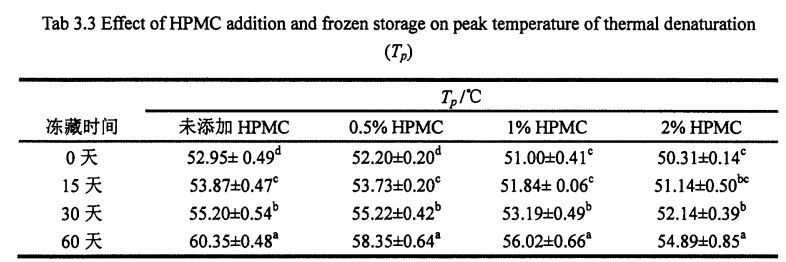
Note: Different superscript lowercase letters in the same column indicate significant difference (P<0.05) In addition, Myers (1990) believed that a higher Ang means that the protein molecule exposes more hydrophobic groups and participates in the denaturation process of the molecule [1231]. Tāpēc sasalšanas laikā tika pakļautas vairāk hidrofobu grupu lipekļa, un HPMC varēja efektīvi stabilizēt lipekļa molekulāro konformāciju.
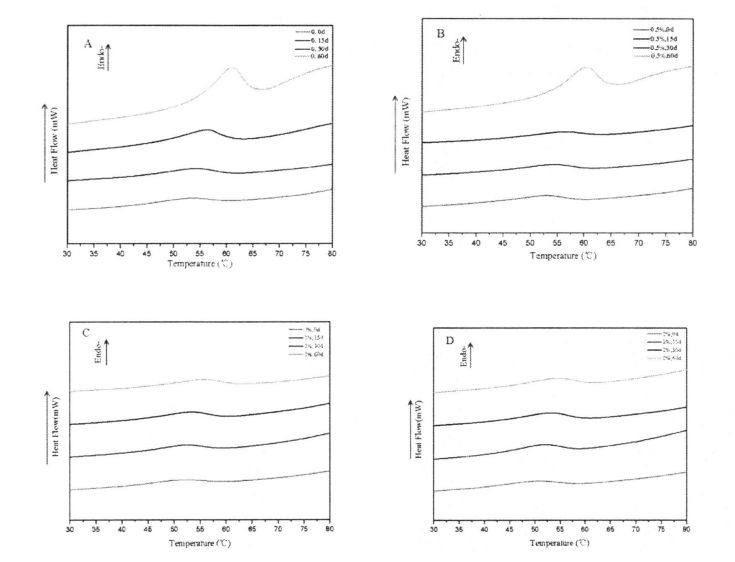
Fig 3.2 Typical DSC thermograms of gluten proteins with 0%HPMC(A);with O.5%HPMC(B); with 1%HPMC(C);with 2%HPMC(D)after different time of frozen storage,from 0d to 60d indicated from the lowest curve to the highest one in each graph. Note: A is the DSC curve of wheat gluten without adding HPMC; B is the addition of O. DSC curve of wheat gluten with 5% HPMC; C ir kviešu lipekļa DSC līkne ar 1% HPMC; D is the DSC curve of wheat gluten with 2% HPMC 3.3.3 Effects of HPMC addition amount and freezing time on free sulfhydryl content (C-SH) Intermolecular and intramolecular covalent bonds are very important for the stability of dough network structure. Disulfīda saite (-SS-) ir kovalenta saite, kas veidojas, dehidrogenējot divas brīvas sulfhidrilgrupas (.sh). Glutenin is composed of glutenin and gliadin, the former can form intramolecular and intermolecular disulfide bonds, while the latter can only form intramolecular disulfide bonds [1241] Therefore, disulfide bonds are an intramolecular/intermolecular disulfide bond. svarīgs šķērssavienojuma veids. Salīdzinot ar 0% pievienošanu, O. C-S-S-S-S-S-S-S-S-S-S-S-S-S-S-S-S-S-S-SKAMA APSTIPRINĀJUMS PĒC 60 SALDĒŠANAS APSTIPRINĀJUMS ir attiecīgi atšķirīgs. Konkrēti, seja bez HPMC pievienota lipeklis C. SH palielinājās par 3,74 "mol/g līdz 8,25" mol/g, bet c.sh, gliemenes, ar lipekli, kas papildināta ar 0,5% un 1% HPMC, palielinājās par 2,76 "mol/g līdz 7,25" "" mol/g un 1,33 "mol/g līdz 5,66" mol/d. 3.3). days of frozen storage, the content of free thiol groups increased significantly [ 1071. It is worth noting that the C-SH of gluten protein was significantly lower than that of other frozen storage periods when the freezing period was 15 days, which may be attributed to the freezing shrinkage effect of gluten protein structure, which makes the More intermolecular and intramolecular disulfide bonds were locally formed in a shorter freezing time [1161 Wang, ET A1.
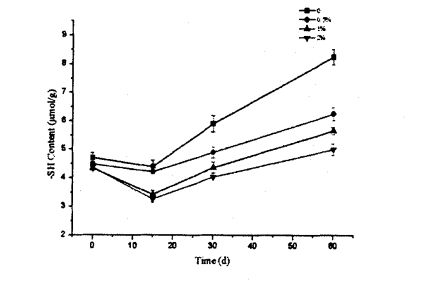
3.3. Attēls. HPMC pievienošanas un saldētas uzglabāšanas ietekme uz brīvās-SH saturu lipekļa olbaltumvielām, kā minēts iepriekš, sasalšanas ūdens var veidot ledus kristālus zemā temperatūrā un izplatīt lipekļa tīkla starpnosacījumos. Tāpēc, pagarinot sasalšanas laiku, ledus kristāli kļūst lielāki, kas nopietnāk izspiež lipekļa olbaltumvielu struktūru un noved pie dažu starpmolekulāru un intramolekulāru disulfīdu saites, kas palielina brīvo sulfhidrilgrupu saturu. No otras puses, eksperimentālie rezultāti parāda, ka HPMC var aizsargāt disulfīda saiti no ledus kristālu ekstrūzijas bojājumiem, tādējādi kavējot lipekļa olbaltumvielu depolimerizācijas procesu. 3.3. 3.4. Attēlā parādīts mitras lipekļa masas sadalījums 0 un 60 dienās ar dažādiem HPMC papildinājumiem, ieskaitot 4 galvenos sadalījuma intervālus, proti, 0,1,1 ms (T21), 1,10 ms (T22), 10,100 ms (miris;) un 1 00-1 000 ms (T24). Bosmans et al. (2012) found a similar distribution of wet gluten mass [1261], and they suggested that protons with relaxation times below 10 ms could be classified as rapidly relaxing protons, which are mainly derived from poor mobility the bound water, therefore, may characterize the relaxation time distribution of bound water bound to a small amount of starch, while Dang may characterize the relaxation time distribution of bound water bound to gluten protein. In addition, Kontogiorgos (2007) - t11¨, the "strands" of the gluten protein network structure are composed of several layers (Sheets) about 5 nm apart, and the water contained in these layers is limited water (or Bulk water, phase water), the mobility of this water is between the mobility of bound water and free water. And T23 can be attributed to the relaxation time distribution of restricted water. The T24 distribution (>100 ms) has a long relaxation time, so it characterizes free water with strong mobility. This water exists in the pores of the network structure, and there is only a weak capillary force with the gluten protein system.
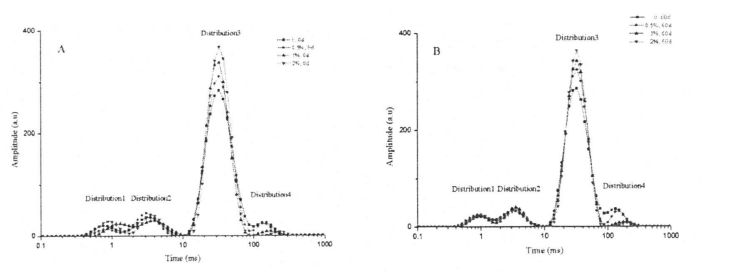
3.4
Piezīme: A un B apzīmē slapja lipekļa šķērsvirziena relaksācijas laiku (n)
Comparing the wet gluten doughs with different addition amounts of HPMC stored in frozen storage for 60 days and unfrozen storage respectively, it was found that the total distribution area of T21 and T24 did not show a significant difference, indicating that the addition of HPMC did not significantly increase the relative amount of bound water. Saturs, kas var būt saistīts ar faktu, ka galvenās ūdens saistošās vielas (lipekļa olbaltumvielas ar nelielu cietes daudzumu) netika ievērojami mainīta, pievienojot nelielu daudzumu HPMC. On the other hand, by comparing the distribution areas of T21 and T24 of wet gluten mass with the same amount of HPMC added for different freezing storage times, there is also no significant difference, which indicates that the bound water is relatively stable during the freezing storage process, and has a negative impact on the environment. Changes are less sensitive and less affected.
However, there were obvious differences in the height and area of T23 distribution of wet gluten mass that was not frozen and contained different HPMC additions, and with the increase of addition, the height and area of T23 distribution increased (Fig. 3.4). This change shows that HPMC can significantly increase the relative content of limited water, and it is positively correlated with the added amount within a certain range. In addition, with the extension of freezing storage time, the height and area of T23 distribution of the wet gluten mass with the same HPMC content decreased to varying degrees. Therefore, compared with bound water, limited water showed a certain effect on freezing storage. Sensitivity. Šī tendence liek domāt, ka mijiedarbība starp lipekļa olbaltumvielu matricu un ierobežoto ūdeni kļūst vājāka. This may be because more hydrophobic groups are exposed during freezing, which is consistent with the thermal denaturation peak temperature measurements. In particular, the height and area of the T23 distribution for the wet gluten mass with 2% HPMC addition did not show a significant difference. This indicates that HPMC can limit the migration and redistribution of water, and can inhibit the transformation of the water state from the restricted state to the free state during the freezing process.
Turklāt mitrās lipekļa masas T24 sadalījuma augstums un laukums ar atšķirīgu HPMC saturu bija ievērojami atšķirīgs (3.4. Att., A), un brīvā ūdens relatīvais saturs tika negatīvi korelēts ar pievienoto HPMC daudzumu. This is just the opposite of the Dang distribution. Tāpēc šis variācijas noteikums norāda, ka HPMC ir ūdens turēšanas spēja un brīvais ūdens pārvērš ierobežotā ūdenī. Tomēr pēc 60 dienu sasalšanas T24 sadalījuma augstums un laukums palielinājās līdz dažāda pakāpei, kas norādīja, ka ūdens stāvoklis sasalšanas procesā mainījās no ierobežota ūdens uz brīvi plūstošu stāvokli. Tas galvenokārt ir saistīts ar lipekļa olbaltumvielu konformācijas maiņu un "slāņa" vienības iznīcināšanu lipekļa struktūrā, kas maina tajā esošā ierobežotā ūdens stāvokli. Lai arī ar sasaluma ūdens saturu, ko nosaka DSC, arī palielinās, pagarinot sasalšanas uzglabāšanas laiku, tomēr, ņemot vērā abu mērījumu metožu atšķirības un raksturošanas principus, sasaldējamais ūdens un brīvais ūdens nav pilnībā līdzvērtīgi. Pēc 60 dienu sasalšanas uzglabāšanas mitrās lipekļa masas ar 2% HPMC, neviens no četriem sadalījumiem neuzrādīja būtiskas atšķirības, norādot, ka HPMC var efektīvi saglabāt ūdens stāvokli, ņemot vērā savas ūdens turēšanas īpašības un mijiedarbību ar glutēnu. and stable liquidity.
Vispārīgi runājot, olbaltumvielu sekundārā struktūra ir sadalīta četros veidos, α-spirālajās, β-saliektajos, β-virsmās un izlases cirtas. Vissvarīgākās sekundārās saites olbaltumvielu telpiskās konformācijas veidošanai un stabilizēšanai ir ūdeņraža saites. Tāpēc olbaltumvielu denaturācija ir ūdeņraža saišu pārrāvuma un konformācijas izmaiņu process.
Fourier transform infrared spectroscopy (FT-IR) has been widely used for high-throughput determination of the secondary structure of protein samples. Raksturīgās joslas olbaltumvielu infrasarkanajā spektrā galvenokārt ietver, Amide I joslu (1700.1600 cm-1), Amide II joslu (1600.1500 cm-1) un Amide III joslu (1350.1200 cm-1). Attiecīgi amīda I josla absorbcijas virsotne rodas no karbonilgrupas stiepšanās vibrācijas (-c = o-.), Amīda II josla galvenokārt ir saistīta ar aminogrupa (-nh-) liekšanas vibrāciju (-nh-) [1271], un amīda III josla galvenokārt ir saistīta ar vibrācijas vibrāciju un. vibration, and has a high sensitivity to changes in protein secondary structure [128'1291. Although the above three characteristic bands are all characteristic infrared absorption peaks of proteins, the specific In other words, the absorption intensity of amide II band is lower, so the semi-quantitative accuracy of protein secondary structure is poor; while the peak absorption intensity of amide I band is higher, so many researchers analyze the secondary structure of protein by this band [ 1301, but the absorption peak of water and the amide I band are overlapped at about 1640 cm. 1 viļņa skaitlis (pārklājas), kas savukārt ietekmē rezultātu precizitāti. Tāpēc ūdens traucējumi ierobežo amīda I joslas noteikšanu olbaltumvielu sekundārās struktūras noteikšanā. Šajā eksperimentā, lai izvairītos no ūdens traucējumiem, analizējot amīda III joslu, tika iegūts četru lipekļa olbaltumvielu sekundāro struktūru relatīvais saturs. Maksimālā pozīcija (viļņa skaita intervāls)
3.4 cilne

Figure 3.5 is the infrared spectrum of the amide III band of gluten protein added with different contents of HPMC for 0 days after being frozen for 0 days after deconvolution and fitting of the second derivative. (2001) izmantoja otro atvasinājumu, lai tas atbilstu dekonvolētajām virsotnēm ar līdzīgām pīķa formām [1321]. Lai kvantitatīvi noteiktu relatīvās satura izmaiņas katrā sekundārajā struktūrā, 3.5. Tabulā ir apkopots relatīvais procentuālais saturs četrās sekundārajās struktūrās lipekļa olbaltumvielās ar atšķirīgu sasalšanas laiku un dažādiem HPMC papildinājumiem (atbilstošais maksimālais integrālais laukums/maksimālais kopējais laukums).
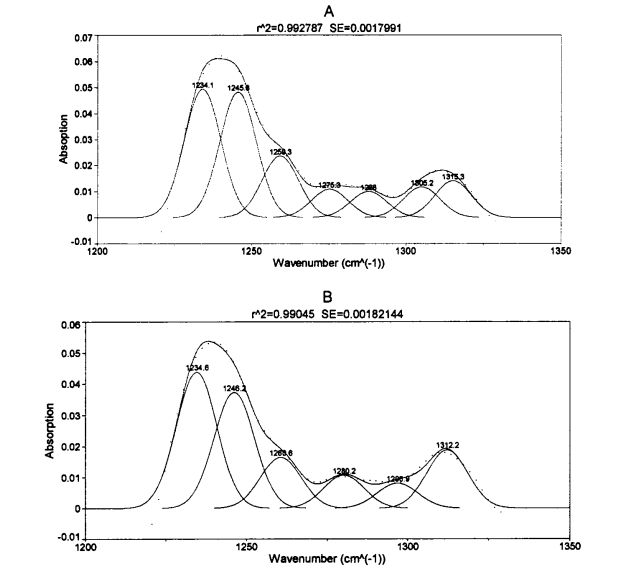
PIEZĪME: A ir kviešu lipekļa olbaltumvielu infrasarkanais spektrs, nepievienojot HPMC 0 dienu saldētām uzglabāšanai; B is the infrared spectrum of wheat gluten protein of frozen storage for 0 days with 2% HPMC added
With the prolongation of frozen storage time, the secondary structure of gluten protein with different additions of HPMC changed to different degrees. Var redzēt, ka gan sasaldēta uzglabāšana, gan HPMC pievienošana ietekmē lipekļa olbaltumvielu sekundāro struktūru. Neatkarīgi no pievienotā HPMC daudzuma B. Salocītā struktūra ir dominējošākā struktūra, kas veido apmēram 60%. Pēc 60 dienu sasaldētas uzglabāšanas pievienojiet 0%, OB lipekli 5% un 1% HPMC. The relative content of folds increased significantly by 3.66%, 1.87% and 1.16%, respectively, which was similar to the results determined by Meziani et al. (2011) [l33J]. Tomēr saldētās uzglabāšanas laikā lipeklim, kas papildināts ar 2% HPMC, nebija būtiskas atšķirības. In addition, when frozen for 0 days, with the increase of HPMC addition, p. The relative content of folds increased slightly, especially when the addition amount was 2%, p. The relative content of folds increased by 2.01%. D. The folded structure can be divided into intermolecular p. Salokošana (ko izraisa olbaltumvielu molekulu agregācija), antiparalēli p. Folded and parallel p. Three substructures are folded, and it is difficult to determine which substructure occurs during the freezing process
changed. Daži pētnieki uzskata, ka B tipa struktūras relatīvā satura palielināšanās izraisīs steriskās konformācijas stingrības un hidrofobitātes paaugstināšanos [41], un citi pētnieki uzskata, ka p. The increase in folded structure is due to part of the new β-Fold formation is accompanied by a weakening of the structural strength maintained by hydrogen bonding [421]. β- The increase in the folded structure indicates that the protein is polymerized through hydrophobic bonds, which is consistent with the results of the peak temperature of thermal denaturation measured by DSC and the distribution of transverse relaxation time measured by low-field nuclear magnetic resonance. Olbaltumvielu denaturācija. On the other hand, added 0.5%, 1% and 2% HPMC gluten protein α-whirling. The relative content of helix increased by 0.95%, 4.42% and 2.03% respectively with the prolongation of freezing time, which is consistent with Wang, et a1. (2014) found similar results [134]. 0 of gluten without added HPMC. There was no significant change in the relative content of helix during the frozen storage process, but with the increase of the addition amount of freeze for 0 days. There were significant differences in the relative content of α-whirling structures.
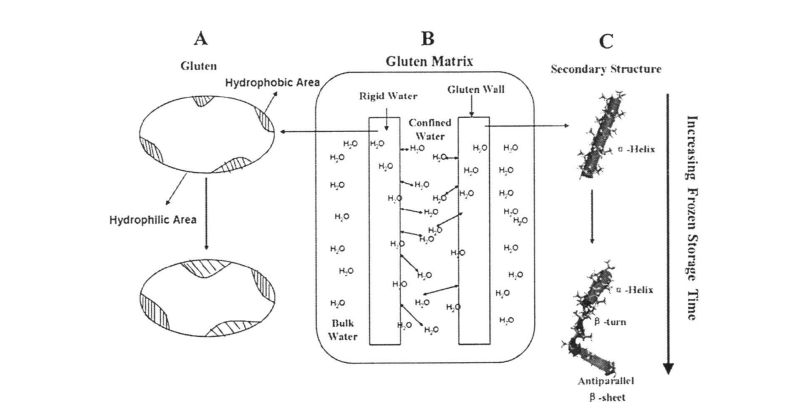
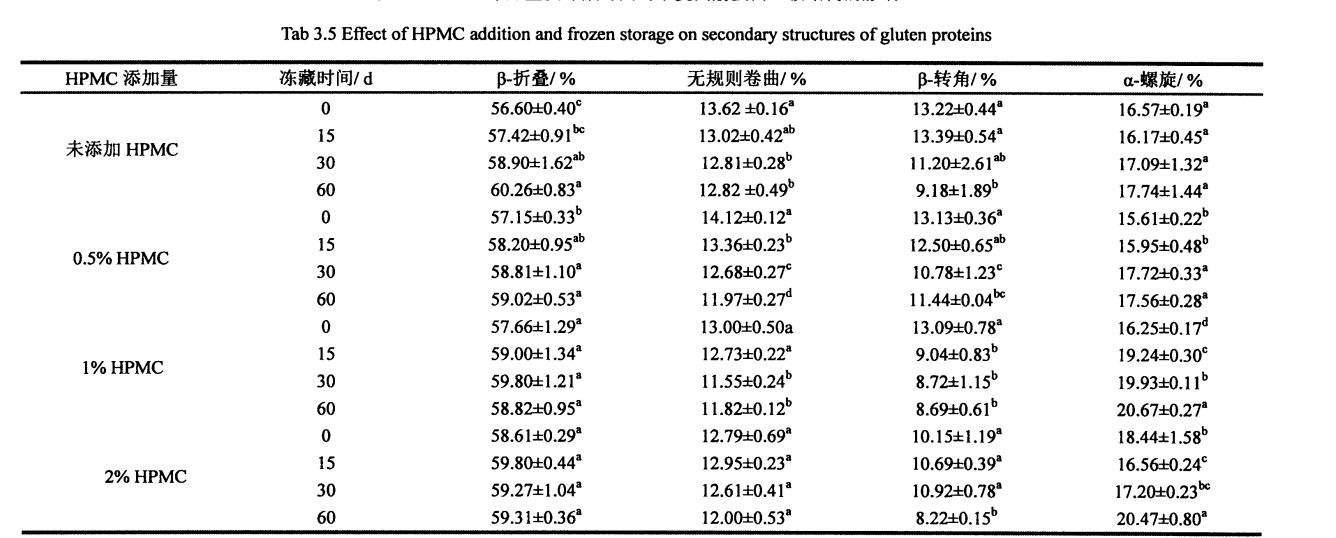
Visi paraugi ar sasalšanas laika pagarinājumu, lpp. Stūru relatīvais saturs tika ievērojami samazināts. Tas parāda, ka β-pagrieziens ir ļoti jutīgs pret sasalšanas ārstēšanu [135. 1361], un neatkarīgi no tā, vai HPMC tiek pievienots vai nē, nav nekādas ietekmes. Wellner, et a1. (2005) proposed that the β-chain turn of gluten protein is related to the β-turn space domain structure of the glutenin polypeptide chain [l 37]. Except that the relative content of random coil structure of gluten protein added with 2% HPMC had no significant change in frozen storage, the other samples were significantly reduced, which may be caused by the extrusion of ice crystals. Turklāt, sasaldējot 0 dienas, α-spirāles, β-lapas un β-pagrieziena lipekļa olbaltumvielu struktūras relatīvais saturs, kas pievienots 2% HPMC, ievērojami atšķīrās no lipekļa olbaltumvielu bez HPMC. Tas var norādīt, ka pastāv mijiedarbība starp HPMC un lipekļa olbaltumvielām, veidojot jaunas ūdeņraža saites un pēc tam ietekmējot olbaltumvielu konformāciju; or HPMC absorbs the water in the pore cavity of the protein space structure, which deforms the protein and leads to more changes between the subunits. tuvu. Β-lapas struktūras relatīvā satura palielināšanās un β-pagrieziena un α-spirāles struktūras relatīvā satura samazināšanās atbilst iepriekšminētajām spekulācijām. Saldēšanas procesa laikā ūdens difūzija un migrācija un ledus kristālu veidošanās iznīcina ūdeņraža saites, kas uztur konformācijas stabilitāti un pakļauj olbaltumvielu hidrofobās grupas. In addition, from the perspective of energy, the smaller the energy of the protein, the more stable it is. Zemā temperatūrā olbaltumvielu molekulu pašorganizācijas izturēšanās (salocīšana un izvēršana) notiek spontāni un izraisa konformācijas izmaiņas.
3.3.
Olbaltumvielu molekulās ietilpst gan hidrofilās, gan hidrofobās grupas. Parasti olbaltumvielu virsma sastāv no hidrofilām grupām, kas var saistīt ūdeni caur ūdeņraža saiti, veidojot hidratācijas slāni, lai novērstu olbaltumvielu molekulas aglomerāciju un saglabātu to konformācijas stabilitāti. The interior of the protein contains more hydrophobic groups to form and maintain the secondary and tertiary structure of the protein through the hydrophobic force. Olbaltumvielu denaturāciju bieži pavada hidrofobu grupu iedarbība un paaugstināta virsmas hidrofobitāte.

Piezīme: tajā pašā rindā ir virsraksts bez m un b, norādot, ka pastāv būtiska atšķirība (<0,05);
Dažādi virsrakstu lielie burti vienā un tajā pašā kolonnā norāda uz būtisku atšķirību (<0,05);
After 60 days of frozen storage, add 0%, O. The surface hydrophobicity of gluten with 5%, 1% and 2% HPMC increased by 70.53%, 55.63%, 43.97% and 36.69%, respectively (Table 3.6). In particular, the surface hydrophobicity of the gluten protein without adding HPMC after being frozen for 30 days has increased significantly (P<0.05), and it is already greater than the surface of the gluten protein with 1% and 2% HPMC added after freezing for 60 days Hydrophobicity. Tajā pašā laikā, pēc 60 dienu sasalušas uzglabāšanas, lipekļa olbaltumvielu virsmas hidrofobitāte, kas pievienota ar atšķirīgu saturu, parādīja būtiskas atšķirības. However, after 60 days of frozen storage, the surface hydrophobicity of gluten protein added with 2% HPMC only increased from 19.749 to 26.995, which was not significantly different from the surface hydrophobicity value after 30 days of frozen storage, and was always lower than other the value of the surface hydrophobicity of the sample. This indicates that HPMC can inhibit the denaturation of gluten protein, which is consistent with the results of DSC determination of the peak temperature of heat deformation. Tas notiek tāpēc, ka HPMC var kavēt olbaltumvielu struktūras iznīcināšanu ar pārkristalizāciju un tā hidrofilitātes dēļ,
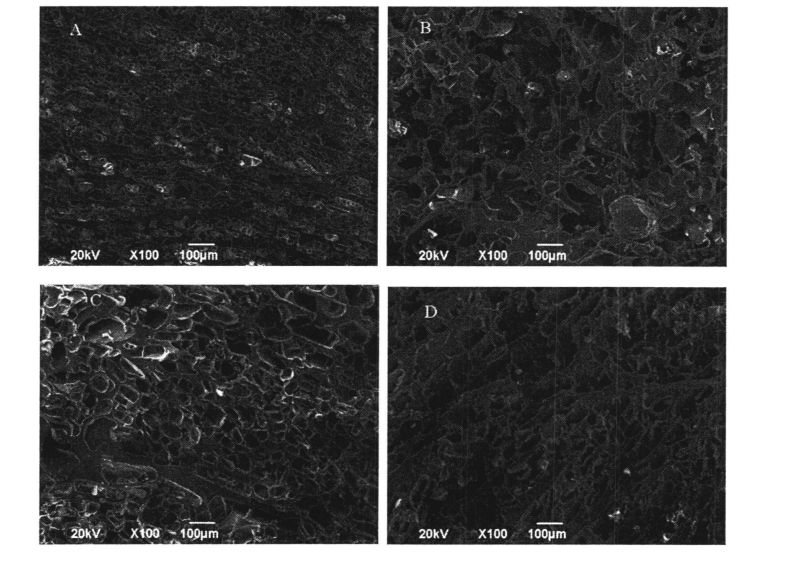
3.7. Attēls. Glutēna mīklas mikrostruktūras SEM attēli , (a) Norādīja lipekļa mīklu ar 0 % HPMC 0D saldētās uzglabāšanas ; (b) Norādīta glutēna mīkla ar 0 % HPMC 60D ; (c) norādīts gluten mīkla ar 2 % HPMC.
Piezīme: A ir lipekļa tīkla mikrostruktūra, nepievienojot HPMC un sasaldēt 0 dienas; B is the microstructure of gluten network without adding HPMC and frozen for 60 days; C is the microstructure of gluten network with 2% HPMC added and frozen for 0 days :D is the gluten network microstructure with 2% HPMC added and frozen for 60 days
After 60 days of frozen storage, the microstructure of the wet gluten mass without HPMC was significantly changed (Fig. 3.7, AB). 0 dienu laikā lipekļa mikrostruktūras ar 2% vai 0% HPMC parādīja pilnīgu formu, lielas
Neliels aptuvenais porains sūklis līdzīga morfoloģija. Tomēr pēc 60 dienu sasaldētas uzglabāšanas šūnas lipekļa mikrostruktūrā bez HPMC kļuva lielākas, neregulāras formas un nevienmērīgi sadalītas (3.7. Att., A, B), galvenokārt tāpēc, ka to izraisa “sienas” lūzums, kas atbilst frezing procesam, kas ir ledus kristāls, un tas ir brīvs. Disulfīda saite, kas ietekmē struktūras stiprumu un integritāti. Kā ziņo Kontogiorgos & Goff (2006) un Kontogiorgos (2007), lipekļa tīkla intersticiālie reģioni tiek izspiests sasaldēšanas saraušanās dēļ, izraisot strukturālu traucējumus [138. 1391]. Turklāt, pateicoties dehidratācijai un kondensācijai, pūkainajā struktūrā tika izveidota salīdzinoši blīva šķiedru struktūra, kas var būt iemesls brīvā tiola satura samazināšanai pēc 15 dienu sasaldētas uzglabāšanas, jo tika izveidotas vairāk disulfīdu saites un sasaldētas uzglabāšanas. Lipekļa struktūra īsāku laiku nebija smagi bojāta, kas atbilst Wang, et A1. (2014) novēroja līdzīgas parādības [134]. Tajā pašā laikā glutēna mikrostruktūras iznīcināšana noved pie brīvas ūdens migrācijas un pārdales, kas atbilst zema lauka laika domēna kodolmagnētiskās rezonanses (TD-NMR) mērījumu rezultātiem. Daži pētījumi [140, 105] ziņoja, ka pēc vairākiem sasalšanas un atkausēšanas cikliem rīsu cietes želatinizācija un mīklas strukturālā izturība kļuva vājāka, un ūdens mobilitāte kļuva augstāka. Nonetheless, after 60 days of frozen storage, the microstructure of gluten with 2% HPMC addition changed less, with smaller cells and more regular shapes than gluten without HPMC addition (Fig. 3.7, B, D). Tas arī norāda, ka HPMC var efektīvi kavēt lipekļa struktūras iznīcināšanu ar pārkristalizāciju.
3.4 Nodaļas kopsavilkums
This experiment investigated the rheology of wet gluten dough and gluten protein by adding HPMC with different contents (0%, 0.5%, 1% and 2%) during freezing storage (0, 15, 30 and 60 days). properties, thermodynamic properties, and effects of physicochemical properties. Pētījumā atklājās, ka ūdens stāvokļa izmaiņas un pārdale sasalšanas uzglabāšanas procesā ievērojami palielināja sasaldējamo ūdens saturu mitrā lipekļa sistēmā, kas noveda pie lipekļa struktūras iznīcināšanas ledus kristālu veidošanās un augšanas dēļ un galu galā izraisīja, ka mīklas apstrādes īpašības ir atšķirīgas. Deterioration of product quality. Frekvences skenēšanas rezultāti parādīja, ka mitrās glutēna masas elastības modulis un viskozais modulis, nepievienojot HPMC, ievērojami samazinājās sasalšanas glabāšanas procesa laikā, un skenēšanas elektronu mikroskops parādīja, ka tā mikrostruktūra ir sabojāta. Brīvās sulfhidrilgrupas saturs tika ievērojami palielināts, un tās hidrofobā grupa bija vairāk pakļauta, kas ievērojami palielināja lipekļa olbaltumvielu termiskās denaturācijas temperatūru un virsmas hidrofobitāti. However, the experimental results show that the addition of I-IPMC can effectively inhibit the changes in the structure and properties of wet gluten mass and gluten protein during freezing storage, and within a certain range, this inhibitory effect is positively correlated with the addition of HPMC. This is because HPMC can reduce the mobility of water and limit the increase of the freezable water content, thereby inhibiting the recrystallization phenomenon and keeping the gluten network structure and the spatial conformation of the protein relatively stable. Tas parāda, ka HPMC pievienošana var efektīvi saglabāt saldētas mīklas struktūras integritāti, tādējādi nodrošinot produkta kvalitāti.
4. nodaļa HPMC pievienošanas ietekme uz cietes struktūru un īpašībām sasaldētā uzglabāšanā
4.1 Ievads
Starch is a chain polysaccharide with glucose as the monomer. key) two types. From a microscopic point of view, starch is usually granular, and the particle size of wheat starch is mainly distributed in two ranges of 2-10 pro (B starch) and 25-35 pm (A starch). Raugoties no kristāla struktūras, cietes granulas ietver kristāliskos reģionus un amorfus reģionus (JE, nekristāliski reģioni), un kristāla formas tiek tālāk sadalītas A, B un C tipos (pēc pilnīgas želatinizācijas tas kļūst par V tipu). Generally, the crystalline region consists of amylopectin and the amorphous region consists mainly of amylose. This is because, in addition to the C chain (main chain), amylopectin also has side chains composed of B (Branch Chain) and C (Carbon Chain) chains, which makes amylopectin appear "tree-like" in raw starch. The shape of the crystallite bundle is arranged in a certain way to form a crystal.
Cietiņa ir viena no galvenajām miltu sastāvdaļām, un tās saturs ir pat aptuveni 75% (sauss). Tajā pašā laikā kā ogļhidrāts, kas plaši sastopams graudos, cieti ir arī galvenais enerģijas avots pārtikā. In the dough system, starch is mostly distributed and attached to the network structure of gluten protein. Apstrādes un uzglabāšanas laikā cietes bieži iziet želatinizācijas un novecošanās posmus.
Among them, starch gelatinization refers to the process in which starch granules are gradually disintegrated and hydrated in a system with high water content and under heating conditions. It can be roughly divided into three main processes. 1) Reversible water absorption stage; before reaching the initial temperature of gelatinization, the starch granules in the starch suspension (Slurry) keep their unique structure unchanged, and the external shape and internal structure basically do not change. Only very little soluble starch is dispersed in the water and can be restored to its original state. 2) The irreversible water absorption stage; as the temperature increases, water enters the gap between the starch crystallite bundles, irreversibly absorbs a large amount of water, causing the starch to swell, the volume expands several times, and the hydrogen bonds between the starch molecules are broken. It becomes stretched and the crystals disappear. At the same time, the birefringence phenomenon of starch, that is, the Maltese Cross observed under a polarizing microscope, begins to disappear, and the temperature at this time is called the initial gelatinization temperature of starch. 3) Starch granule disintegration stage; Cietes molekulas pilnībā nonāk šķīduma sistēmā, veidojot cietes pastu (pastas/cietes želeju), šajā laikā sistēmas viskozitāte ir lielākā, un birefringences fenomens pilnībā izzūd, un šajā laikā temperatūru sauc arī par visu cietes želatinizācijas temperatūru, želatinētu starču sauc arī par α-zvaigžņu [141]. Kad mīkla ir pagatavota, cietes želatinizācija nodrošina ēdienu ar unikālo tekstūru, garšu, garšu, krāsu un apstrādes īpašībām.
In general, starch gelatinization is affected by the source and type of starch, the relative content of amylose and amylopectin in starch, whether starch is modified and the method of modification, addition of other exogenous substances, and dispersion conditions (such as The influence of salt ion species and concentration, pH value, temperature, moisture content, etc.) [142-150]. Tāpēc, mainot cietes struktūru (virsmas morfoloģiju, kristālisko struktūru utt.), Attiecīgi tiks ietekmēta cietes želatinizācijas īpašības, reoloģiskās īpašības, novecošanās īpašības, sagremojamība utt.
Many studies have shown that the gel strength of starch paste decreases, it is easy to age, and its quality deteriorates under the condition of freezing storage, such as Canet, et a1. (2005) studied the effect of freezing temperature on the quality of potato starch puree; Ferrero, et a1. (1993) izpētīja sasalšanas ātruma un dažāda veida piedevu ietekmi uz kviešu un kukurūzas cietes pastas īpašībām [151-156]. However, there are relatively few reports on the effect of frozen storage on the structure and properties of starch granules (native starch), which needs to be further explored. Saldēta mīkla (izņemot iepriekš pagatavotu saldētu mīklu) ir negelatinētu granulu veidā sasaldētas uzglabāšanas stāvoklī. Tāpēc vietējās cietes struktūras un strukturālo izmaiņu izpēte, pievienojot HPMC, ir zināma ietekme uz saldētas mīklas apstrādes īpašību uzlabošanu. nozīme.
4.2.1 Eksperimentālie materiāli
Kviešu ciete Binzhou Zhongyu Food Co., Ltd.; HPMC Aladdin (Shanghai) Chemical Reagent Co., Ltd.;
Aprīkojuma nosaukums
BSAL24S elektroniskais līdzsvars
BCD-201LCT ledusskapis
Discovery R3 Rotācijas reometrs
D/Max2500V tips X. Ray difraktometrs
Ražotājs
Huangshi Hengfeng Medical Equipment Co., Ltd.
Rigaku Manufacturing Co., Ltd.
Huangshi Hengfeng Medical Equipment Co., Ltd.
4.2.3 Eksperimentālā metode
4.2.3.1 cietes suspensijas sagatavošana un saldēta glabāšana
Weigh 1 g of starch, add 9 mL of distilled water, fully shake and mix to prepare a 10% (w/w) starch suspension. Pēc tam novietojiet parauga šķīdumu. 18 ℃ refrigerator, frozen storage for 0, 15 d, 30 d, 60 d, of which 0 day is the fresh control. Add 0.5%, 1%, 2% (w/w) HPMC instead of the corresponding quality starch to prepare samples with different addition amounts, and the rest of the treatment methods remain unchanged.
4.2.3.2 Reoloģiskās īpašības
(1) cietes želatinizācijas īpašības
Šajā eksperimentā ātrs vīzītāja vietā tika izmantots reometrs, lai izmērītu cietes želatinizācijas īpašības. Skatīt Bae et A1. (2014) metode [1571] ar nelielām modifikācijām. Konkrētie programmas parametri ir iestatīti šādi: izmantojiet plāksni ar 40 dzirnavu diametru, sprauga (sprauga) ir 1000 mm, un rotācijas ātrums ir 5 rad/s; I) inkubēt 50 ° C 1 minūtē; ii) pie 5. C/min, kas uzkarsēts līdz 95 ° C; iii) kept at 95°C for 2.5 min, iv) then cooled to 50°C at 5°C/min; v) visbeidzot turēt 5 minūtes 50 ° C temperatūrā.
The above gelatinized starch paste was subjected to the Steady Flow Test, according to the method of Achayuthakan & Suphantharika [1591, the parameters were set to: Flow Sweep mode, stand at 25°C for 10 min, and the shear rate scan range was 1) 0.1 S one. 100s ~, 2) 100s ~. 0,1 s ~, dati tiek savākti logaritmiskajā režīmā, un 10 datu punktus (zemes gabalus) reģistrē ik pēc 10 reizes lielāku bīdes ātrumu, un, visbeidzot, bīdes ātrumu (bīdes ātrumu, Si) tiek uzskatīts par abscisu, un bīdes viskozitāte (viskozitāte, pa · s) ir ordināta reoloģiskā līkne. Use Origin 8.0 to perform nonlinear fitting of this curve and obtain the relevant parameters of the equation, and the equation satisfies the power law (Power Law), that is, t/=K), nI, where M is the shear viscosity (pa ·s), K is the consistency coefficient (Pa ·s), is the shear rate (s. 1), and n is the flow behavior index (Flow Behavior Index, dimensionless).
4.2.3.3 cietes pastas gēla īpašības
Take 2.5 g of amyloid and mix it with distilled water in a ratio of 1:2 to make starch milk. Saldējiet 18 ° C temperatūrā 15 dienas, 30 dienas un 60 dienas. Pievienojiet 0,5, 1, 2% HPMC (masas/w), lai aizstātu tādas pašas kvalitātes cieti, un citas sagatavošanas metodes paliek nemainīgas. After the freezing treatment is completed, take it out, equilibrate at 4 °C for 4 h, and then thaw at room temperature until it is tested.
(3) cietes želejas stiprums (gēla stiprums)
Pēc tam slauciet svārstību frekvenci, iestatiet celma daudzumu (celmu) uz 0,1% (saskaņā ar celma slaucīšanas rezultātiem) un iestatiet frekvences diapazonu uz O. 1 līdz 10 Hz. Katru paraugu atkārtoja trīs reizes.
After the corresponding freezing treatment time, the samples were taken out, thawed completely, and dried in an oven at 40 °C for 48 h. Finally, it was ground through a 100-mesh sieve to obtain a solid powder sample for use (suitable for XRD testing). Skatīt Xie, et A1. (2014) method for sample preparation and determination of thermodynamic properties '1611, weigh 10 mg of starch sample into a liquid aluminum crucible with an ultra-micro analytical balance, add 20 mg of distilled water in a ratio of 1:2, press and seal it and place it at 4 °C In the refrigerator, equilibrated for 24 h. Freeze at 18°C (0, 15, 30 and 60 days). Add 0.5%, 1%, 2% (w/w) HPMC to replace the corresponding quality of starch, and other preparation methods remain unchanged. Pēc tam, kad sasalšanas laiks ir beidzies, 4 stundas izņemiet tīģeli un līdzsvarojiet 4 ° C temperatūrā.
(3) Želatinizācijas temperatūras un entalpijas maiņas noteikšana
Taking the blank crucible as a reference, the nitrogen flow rate was 50 mL/min, equilibrated at 20 °C for 5 min, and then heated to 100 °C at 5 °C/min. Visbeidzot, siltuma plūsma (siltuma plūsma, MW) ir ordinātas DSC līkne, un želatinizācijas virsotne tika integrēta un analizēta ar Universal Analysis 2000. Katrs paraugs tika atkārtots vismaz trīs reizes.
4.2.3.5 XRD mērīšana
The thawed frozen starch samples were dried in an oven at 40 °C for 48 h, then ground and sieved through a 100-mesh sieve to obtain starch powder samples. Take a certain amount of the above samples, use D/MAX 2500V type X. The crystal form and relative crystallinity were determined by X-ray diffractometer. Eksperimentālie parametri ir spriegums 40 kV, strāva 40 mA, izmantojot Cu. Ks kā X. Ray Source. Istabas temperatūrā skenēšanas leņķa diapazons ir 30–400, un skenēšanas ātrums ir 20/min. Relatīvā kristalitāte (%) = kristalizācijas maksimālā laukums/kopējais laukums x 100%, kur kopējais laukums ir fona laukuma un maksimālā integrālā laukuma summa [1 62].
Take 0.1 g of the dried, ground and sieved amyloid into a 50 mL centrifuge tube, add 10 mL of distilled water to it, shake it well, let it stand for 0.5 h, and then place it in a 95°C water bath at a constant temperature. Pēc 30 minūtēm pēc želatinizācijas pabeigšanas izņemiet centrifūgas cauruli un 10 minūtes novietojiet ledus vannā, lai ātra dzesēšana. Finally, centrifuge at 5000 rpm for 20 min, and pour off the supernatant to obtain a precipitate. Swelling Power=precipitation mass/sample mass [163].
4.2.3.7 Datu analīze un apstrāde
All experiments were repeated at least three times unless otherwise specified, and the experimental results were expressed as mean and standard deviation. SPSS Statistic 19 was used for analysis of variance (Analysis of Variance, ANOVA) with a significance level of 0.05; Korelācijas diagrammas tika uzzīmētas, izmantojot izcelsmi 8.0.
4.3 Analīze un diskusija
Pieskarieties 4.1 kviešu cietes sastāvdaļas saturam

4.3.2. HPMC pievienošanas daudzuma un saldēta uzglabāšanas laika ietekme uz kviešu cietes želatinizācijas īpašībām
Cietes suspensiju ar noteiktu koncentrāciju karsē ar noteiktu sildīšanas ātrumu, lai cieti želatīnētu. After starting to gelatinize, the turbid liquid gradually becomes pasty due to the expansion of starch, and the viscosity increases continuously. Subsequently, the starch granules rupture and the viscosity decreases. When the paste is cooled at a certain cooling rate, the paste will gel, and the viscosity value will further increase. The viscosity value when it is cooled to 50 °C is the final viscosity value (Figure 4.1).
Table 4.2 lists the influence of several important indicators of starch gelatinization characteristics, including gelatinization peak viscosity, minimum viscosity, final viscosity, decay value and appreciation value, and reflects the effect of HPMC addition and freezing time on starch paste. effects of chemical properties. The experimental results show that the peak viscosity, the minimum viscosity and the final viscosity of starch without frozen storage increased significantly with the increase of HPMC addition, while the decay value and recovery value decreased significantly. Specifically, the peak viscosity gradually increased from 727.66+90.70 CP (without adding HPMC) to 758.51+48.12 CP (adding 0.5% HPMC), 809.754-56.59 CP (adding 1 %HPMC), and 946.64+9.63 CP (adding 2% HPMC); the minimum viscosity was increased from 391.02+18.97 CP (blank not adding) to 454.95+36.90 (adding O .5% HPMC), 485.56+54.0.5 (add 1% HPMC) and 553.03+55.57 CP (add 2% HPMC); the final viscosity is from 794.62.412.84 CP ( Without adding HPMC) increased to 882.24±22.40 CP (adding 0.5% HPMC), 846.04+12.66 CP (adding 1% HPMC) and 910.884-34.57 CP (adding 2 %HPMC); Tomēr vājināšanās vērtība pakāpeniski samazinājās no 336,644-71,73 CP (nepievienojot HPMC) 303,564-11,22 CP (pievienojot 0,5% HPMC), 324,19 ± 2,54 cp (pievienojiet pievienošanu
With 1% HPMC) and 393.614-45.94 CP (with 2% HPMC), the retrogradation value decreased from 403.60+6.13 CP (without HPMC) to 427.29+14.50 CP, respectively (0.5% HPMC added), 360.484-41.39 CP (15 HPMC added) and 357.85+21.00 CP (2% HPMC added). This and the addition of hydrocolloids such as xanthan gum and guar gum obtained by Achayuthakan & Suphantharika (2008) and Huang (2009) can increase the gelatinization viscosity of starch while reducing the retrogradation value of starch. This may be mainly because HPMC acts as a kind of hydrophilic colloid, and the addition of HPMC increases the gelatinization peak viscosity due to the hydrophilic group on its side chain which makes it more hydrophilic than starch granules at room temperature. Turklāt HPMC termiskās želatinizācijas procesa (termogelācijas procesa) temperatūras diapazons ir lielāks nekā cietes (rezultāti nav parādīti), tāpēc HPMC pievienošana var efektīvi nomākt krasi viskozitātes samazināšanos cietes granulu sadalīšanās dēļ. Therefore, the minimum viscosity and final viscosity of starch gelatinization increased gradually with the increase of HPMC content.
On the other hand, when the amount of HPMC added was the same, the peak viscosity, minimum viscosity, final viscosity, decay value and retrogradation value of starch gelatinization increased significantly with the extension of freezing storage time. Specifically, the peak viscosity of starch suspension without adding HPMC increased from 727.66±90.70 CP (frozen storage for 0 days) to 1584.44+68.11 CP (frozen storage for 60 days); Pievienojot 0,5, cietes suspensijas viskozitāte ar %HPMC palielinājās no 758,514-48,12 CP (sasalšana 0 dienas) līdz 1415,834-45,77 cp (sasalšana 60 dienas); Cietes suspensija ar 1% HPMC pievienoja cietes šķidruma viskozitāti, kas palielinājās no 809,754-56,59 CP (sasalšanas krātuve 0 dienas) līdz 1298.19- ± 78,13 cp (saldēta krātuve 60 dienas); Kamēr cietes suspensija ar 2% HPMC CP pievienoja želatinizācijas maksimālo viskozitāti no 946,64 ± 9,63 cp (0 dienas sasaldētas) palielinājās līdz 1240,224-94,06 cp (60 dienas sasaldētas). Tajā pašā laikā zemākā cietes suspensijas viskozitāte bez HPMC tika palielināta no 391,02-41 8,97 CP (sasalšana 0 dienas) līdz 556,77 ± 29,39 cp (sasalšana 60 dienas); adding 0.5 The minimum viscosity of the starch suspension with %HPMC increased from 454.954-36.90 CP (freezing for 0 days) to 581.934-72.22 CP (freezing for 60 days); Cietes suspensija ar 1% HPMC pievienoja minimālo šķidruma viskozitāti palielinājās no 485,564-54,05 cp (sasalšana 0 dienas) līdz 625,484-67,17 cp (sasalšana 60 dienas); while the starch suspension added 2% HPMC CP gelatinized The lowest viscosity increased from 553.034-55.57 CP (0 days frozen) to 682.58 ± 20.29 CP (60 days frozen).

The final viscosity of starch suspension without adding HPMC increased from 794.62 ± 12.84 CP (frozen storage for 0 days) to 1413.15 ± 45.59 CP (frozen storage for 60 days). Cietes suspensijas maksimālā viskozitāte palielinājās no 882,24 ± 22,40 cp (saldēta krātuve 0 dienas) līdz 1322,86 ± 36,23 cp (saldēta krātuve 60 dienas); the peak viscosity of starch suspension added with 1% HPMC The viscosity increased from 846.04 ± 12.66 CP (frozen storage 0 days) to 1291.94 ± 88.57 CP (frozen storage for 60 days); un cietes suspensijas viskozitāte, kas pievienota ar 2% HPMC, palielinājās no 91 0,88 ± 34,57 cp, palielinājās no 2% HPMC viskozitāte no 91 0,88 ± 34,57
(Saldēta uzglabāšana 0 dienas) palielinājās līdz 1198,09 ± 41,15 cp (saldēta glabāšana 60 dienas). Attiecīgi cietes suspensijas vājināšanās vērtība, nepievienojot HPMC, palielinājās no 336,64 ± 71,73 cp (saldēta krātuve 0 dienas) līdz 1027,67 ± 38,72 cp (saldēta krātuve 60 dienas); adding 0.5 The attenuation value of starch suspension with %HPMC increased from 303.56±11.22 CP (frozen storage for 0 days) to 833.9±26.45 CP (frozen storage for 60 days); Cietes suspensija ar 1% HPMC pievienoja šķidruma vājināšanās vērtību no 324,19 ± 2,54 cp (sasalšana 0 dienas) līdz 672,71 ± 10,96 cp (sasalšana 60 dienas); while adding 2% HPMC,the attenuation value of the starch suspension increased from 393.61 ± 45.94 CP (freezing for 0 days) to 557.64 ± 73.77 CP (freezing for 60 days); Kamēr cietes suspensija bez HPMC pievienoja, retrogradācijas vērtība palielinājās no 403,60 ± 6,13 C
P (frozen storage for 0 days) to 856.38 ± 16.20 CP (frozen storage for 60 days); the retrogradation value of starch suspension added with 0.5% HPMC increased from 427 .29±14.50 CP (frozen storage for 0 days) increased to 740.93±35.99 CP (frozen storage for 60 days); Cietes suspensijas retrogradācijas vērtība, kas pievienota ar 1% HPMC, palielinājās no 360,48 ± 41. 39 CP (saldēta uzglabāšana 0 dienas) palielinājās līdz 666,46 ± 21,40 cp (saldēta uzglabāšana 60 dienas); Kamēr cietes suspensijas retrogradācijas vērtība, kas pievienota ar 2% HPMC, palielinājās no 357,85 ± 21,00 cp (saldēta krātuve 60 dienas). 0 dienas) palielinājās līdz 515,51 ± 20,86 cp (60 dienas sasalis).
It can be seen that with the prolongation of freezing storage time, the starch gelatinization characteristics index increased, which is consistent with Tao et a1. F2015) 1. Saskaņā ar eksperimentālajiem rezultātiem viņi atklāja, ka, palielinoties sasaldēšanas un atkausēšanas ciklu skaitam, cietes želatinizācijas maksimālā viskozitāte, minimālā viskozitāte, galīgā viskozitāte, sabrukšanas vērtība un cietes želatinizācijas retrogradācijas vērtība [166j]. This is mainly because in the process of freezing storage, the amorphous region (Amorphous Region) of starch granules is destroyed by ice crystallization, so that the amylose (the main component) in the amorphous region (non-crystalline region) undergoes phase separation (Phase. separated) phenomenon, and dispersed in the starch suspension, resulting in an increase in the viscosity of starch gelatinization, and an increase in the related attenuation value and retrogradation value. Tomēr HPMC pievienošana kavēja ledus kristalizācijas ietekmi uz cietes struktūru. Therefore, the peak viscosity, minimum viscosity, final viscosity, decay value and retrogradation rate of starch gelatinization increased with the addition of HPMC during frozen storage. palielināt un samazināties secīgi.

4. attēls. Kviešu cietes ielīmēšanas līknes bez HPMC (A) vai ar 2 % HPMC①)


No 4.3. Tabulas var redzēt, ka visi plūsmas raksturlielumi, 2, ir mazāki par 1. Tāpēc cietes pastas (neatkarīgi no tā, vai tiek pievienota HPMC, vai arī tā ir iesaldēta vai nē) pieder pseidoplastiskam šķidrumam, un visiem parāda cirpšanas retināšanas fenomenu (palielinoties bīdes ātrumam, samazinoties bīdes bīdes viskozitātei). Turklāt bīdes ātrums skenēšana svārstījās attiecīgi no 0,1 s. 1 palielinājās līdz 100 s ~, un pēc tam samazinājās no 100 SD līdz O. Reoloģiskās līknes, kas iegūtas 1 SD, pilnībā nepārklājas, un arī K, S uzstādītie rezultāti ir atšķirīgi, tāpēc cietes pastas ir tiksotropisks pseidoplastisks šķidrums (neatkarīgi no tā, vai HPMC ir pievienots, vai arī tas ir saldēts vai nav). Tomēr tajā pašā sasalšanas krātuves laikā, palielinoties HPMC pievienošanai, atšķirība starp abu skenēšanas K N vērtību pielāgošanas rezultātiem pakāpeniski samazinājās, kas norāda, ka HPMC pievienošana padara cietes pastas struktūru bīdes stresa apstākļos. It remains relatively stable under the action and reduces the "thixotropic ring"
(Tixotropic Loop) laukums, kas ir līdzīgs Temsiripong, et A1. (2005) ziņoja par tādu pašu secinājumu [167]. This may be mainly because HPMC can form intermolecular cross-links with gelatinized starch chains (mainly amylose chains), which "bound" the separation of amylose and amylopectin under the action of shearing force. , so as to maintain the relative stability and uniformity of the structure (Figure 4.2, the curve with shear rate as abscissa and shear stress as ordinate).
On the other hand, for the starch without frozen storage, its K value decreased significantly with the addition of HPMC, from 78.240±1.661 Pa ·sn (without adding HPMC) to 65.240±1.661 Pa ·sn (without adding HPMC), respectively. 683 ± 1,035 PA · SN (pievienojiet 0,5% rokas MC), 43,122 ± 1,047 PA · SN (pievienojiet 1% HPMC) un 13,926 ± 0,330PA · SN (pievienojiet 2% HPMC), bet N vērtība ievērojami palielinājās no 0,277 ± 0,011 (bez pievienošanas HPMC) līdz 0,277 ± 0,011. 310 ± 0.009 (add 0.5% HPMC), O. 323 ± 0.013 (add 1% HPMC) and O. 43 1 ± 0.0 1 3 (adding 2% HPMC), which is similar to the experimental results of Techawipharat, Suphantharika, & BeMiller (2008) and Turabi, Sumnu, & Sahin (2008), and the increase of n value shows that the addition of HPMC makes the fluid has a tendency to change from pseudoplastic to Newtonian [168'1691]. Tajā pašā laikā, kad cieti, kas uzglabāta sasaldēta 60 dienas, k, n vērtības parādīja tādu pašu izmaiņu noteikumu, palielinoties HPMC pievienošanai.
Tomēr, pagarinot sasalšanas krātuves laiku, K un N vērtības palielinājās līdz dažādām pakāpēm, starp kurām K vērtība palielinājās no 78,240 ± 1,661 Pa · Sn (nepiešķirta, 0 dienas) līdz attiecīgi līdz 95,570 ± 1. 2.421 Pa·sn (no addition, 60 days), increased from 65.683±1.035 Pa ·S n (addition of O. 5% HPMC, 0 days) to 51.384±1.350 Pa ·S n (Add to 0.5% HPMC, 60 days), increased from 43.122±1.047 Pa ·sn (adding 1% HPMC, 0 days) to 56,538 ± 1,378 PA · SN (pievienojot 1% HPMC, 60 dienas)) un palielinājās no 13,926 ± 0,330 Pa · Sn (pievienojot 2% HPMC, 0 dienas) līdz 16,064 ± 0,465 Pa · SN (pievienojot 2% HPMC, 60 dienas); 0.277 ± 0.011 (without adding HPMC, 0 days) rose to O. 334±0.014 (no addition, 60 days), increased from 0.310±0.009 (0.5% HPMC added, 0 day) to 0.336±0.014 (0.5% HPMC added, 60 days), from 0.323 ± 0.013 (add 1% HPMC, 0 days) to 0.340 ± 0.013 (add 1% HPMC, 60 days), and from 0.431 ± 0.013 (add 1% HPMC, 60 days) 2% HPMC, 0 days) to 0.404+0.020 (add 2% HPMC, 60 days). By comparison, it can be found that with the increase of the addition amount of HPMC, the change rate of K and Knife value decreases successively, which shows that the addition of HPMC can make the starch paste stable under the action of shearing force, which is consistent with the measurement results of starch gelatinization characteristics. konsekvents.
4.3.4. HPMC pievienošanas daudzuma un saldēta glabāšanas laika ietekme uz cietes pastas dinamisko viskoelastību
Dinamiskā frekvences slaucīšana var efektīvi atspoguļot materiāla viskoelastību, un cietes pastai to var izmantot, lai raksturotu tā želejas stiprību (gēla stiprību). Figure 4.3 shows the changes of storage modulus/elastic modulus (G') and loss modulus/viscosity modulus (G") of starch gel under the conditions of different HPMC addition and freezing time.

4. attēls. HPMC pievienošanas un saldētas uzglabāšanas ietekme uz cietes pastas elastīgo un viskozo moduli
PIEZĪME: A ir nepiespiestas HPMC cietes viskoelastības maiņa ar sasalšanas glabāšanas laika pagarinājumu; B ir O. pievienošana 5% HPMC cietes viskoelastības maiņai ar sasalšanas glabāšanas laika pagarinājumu; C ir 1% HPMC cietes viskoelastības maiņa ar sasalšanas glabāšanas laika pagarinājumu; D ir 2% HPMC cietes viskoelastības maiņa ar sasalšanas glabāšanas laika pagarinājumu
The starch gelatinization process is accompanied by the disintegration of starch granules, the disappearance of the crystalline region, and the hydrogen bonding between starch chains and moisture, the starch gelatinized to form a heat-induced (Heat. induced) gel with a certain gel strength. Kā parādīts 4.3. Attēlā, par cieti bez saldētas uzglabāšanas, palielinoties HPMC pievienošanai, cietes G 'ievērojami samazinājās, savukārt G "nebija būtiskas atšķirības, un tan 6 palielinājās (šķidrums. 1ike), kas parāda, ka želatinizācijas procesa laikā HPMC mijiedarbojas ar cieti, un ūdens zaudēšanas laikā hPMC, kas tiek iegūta ūdens, ir HPMC. the same time, Chaisawang & Suphantharika (2005) found that, adding guar gum and xanthan gum to tapioca starch, the G' of the starch paste also decreased [170]. In addition, with the extension of the freezing storage time, the G' of starch gelatinized decreased to different degrees. This is mainly because during the frozen storage process of starch, the amylose in the amorphous region of starch granules is separated to form damaged starch (Damaged Starch), which reduces the degree of intermolecular cross-linking after starch gelatinization and the degree of cross-linking after cross-linking. Stability and compactness, and the physical extrusion of ice crystals makes the arrangement of "micelles" (microcrystalline structures, mainly composed of amylopectin) in the starch crystallization area more compact, increasing the relative crystallinity of starch, and at the same time , resulting in insufficient combination of molecular chain and water after starch gelatinization, low extension of molecular chain (molecular chain mobility), and finally caused the gel strength of starch to decline. However, with the increase of HPMC addition, the decreasing trend of G' was suppressed, and this effect was positively correlated with the addition of HPMC. This indicated that the addition of HPMC could effectively inhibit the effect of ice crystals on the structure and properties of starch under frozen storage conditions.
The swelling ratio of starch can reflect the size of starch gelatinization and water swelling, and the stability of starch paste under centrifugal conditions. As shown in Figure 4.4, for starch without frozen storage, with the increase of HPMC addition, the swelling force of starch increased from 8.969+0.099 (without adding HPMC) to 9.282- -L0.069 (adding 2% HPMC), which shows that the addition of HPMC increases the swelling water absorption and makes starch more stable after gelatinization, which is consistent with the Cietes želatinizācijas īpašību secinājums. However, with the extension of frozen storage time, the swelling power of starch decreased. Compared with 0 days of frozen storage, the swelling power of starch decreased from 8.969-a:0.099 to 7.057+0 after frozen storage for 60 days, respectively. .007 (no HPMC added), reduced from 9.007+0.147 to 7.269-4-0.038 (with O.5% HPMC added), reduced from 9.284+0.157 to 7.777 +0.014 (adding 1% HPMC), reduced from 9.282+0.069 to 8.064+0.004 (adding 2% HPMC). Rezultāti parādīja, ka cietes granulas tika sabojātas pēc sasalšanas uzglabāšanas, kā rezultātā tika nogulsnēti šķīstošās cietes un centrifugēšanas daļa. Tāpēc cietes šķīdība palielinājās un pietūkuma jauda samazinājās. Turklāt pēc sasalšanas uzglabāšanas cietes želatinizēta cietes pasta, tās stabilitāte un ūdens noturības spēja samazinājās un abu kopējā darbība samazināja cietes pietūkuma spēku [1711]. No otras puses, palielinoties HPMC pievienošanai, cietes pietūkuma jaudas samazināšanās pakāpeniski samazinājās, norādot, ka HPMC var samazināt bojātās cietes daudzumu, kas izveidots sasalšanas uzglabāšanas laikā un kavē cietes granulu bojājumu pakāpi.
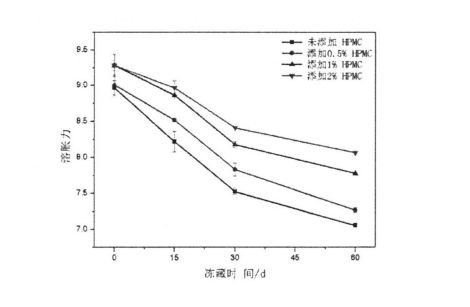
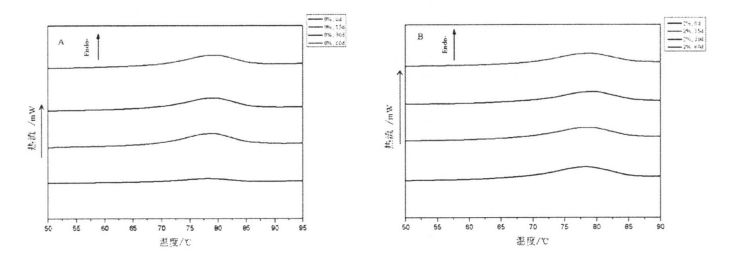
4.5. HPMC pievienošanas un saldētas uzglabāšanas ietekme uz kviešu cietes ielīmēšanas termiskajām īpašībām
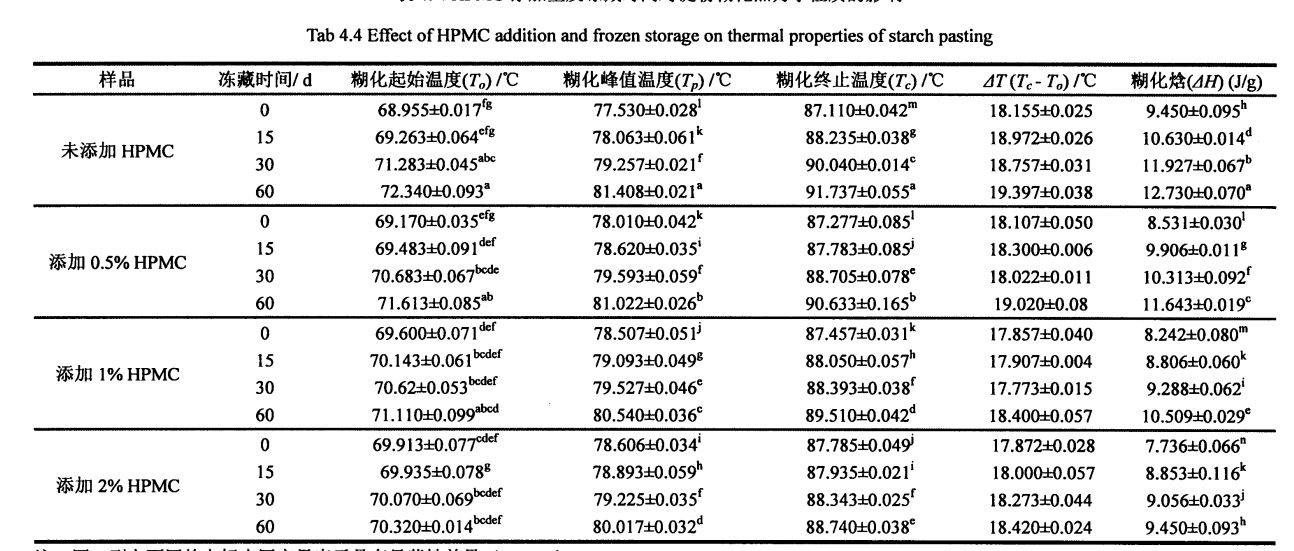
Kā parādīts 4.4. Tabulā, lai iegūtu svaigu amiloīdu, palielinoties HPMC pievienošanai, cietei L nav būtisku atšķirību, bet ievērojami palielinās no 77,530 ± 0,028 (nepievienojot HPMC) līdz 78,010 ± 0,042 (pievienot 0,5% HPMC), 78,507 ± 0,051 (pievienots 1% HPMC) un 78,607 ± 0,051 (pievienots 1% HPMC) un 78,607 ± 0,051 (pievienots 1% HPMC) un 78,607 ± ± 0,051 (pievienots 1% HPMC) un 78,606 ± ± 0,051 (pievienots 1% HPMC). 2% HPMC), bet 4H ir ievērojams samazinājums no 9,450 ± 0,095 (nepievienojot HPMC) 8,53 ± 0,030 (pievienojot 0,5% HPMC), 8,242A: 0,080 (pievienojot 1% HPMC) un 7 .736 ± 0,066 (pievienots 2% HPMC). This is similar to Zhou, et a1. (2008) found that adding a hydrophilic colloid decreased the starch gelatinization enthalpy and increased the starch gelatinization peak temperature [172]. Tas ir galvenokārt tāpēc, ka HPMC ir labāka hidrofilitāte, un to ir vieglāk apvienot ar ūdeni nekā cieti. At the same time, due to the large temperature range of the thermally accelerated gelation process of HPMC, the addition of HPMC increases the peak gelatinization temperature of starch, while the gelatinization Enthalpy decreases.
On the other hand, starch gelatinization To, T p, Tc, △T and △Hall increased with the extension of freezing time. Specifically, starch gelatinization with 1% or 2% HPMC added had no significant difference after freezing for 60 days, while starch without or with 0.5% HPMC was added from 68.955±0.01 7 (frozen storage for 0 days) increased to 72.340 ± 0.093 (frozen storage for 60 days), and from 69.170 ± 0.035 (frozen storage for 0 days) to 71.613 ± 0.085 (frozen storage for 0 days) 60 days); Pēc 60 dienu sasaldētas uzglabāšanas cietes želatinizācijas augšanas ātrums samazinājās, palielinoties HPMC pievienošanai, piemēram, cieti bez HPMC, kas pievienots no 77,530 ± 0,028 (saldēta krātuve 0 dienas) līdz 81,028. 408 ± 0.021 (frozen storage for 60 days), while the starch added with 2% HPMC increased from 78.606 ± 0.034 (frozen storage for 0 days) to 80.017 ± 0.032 (frozen storage for 60 days). days); Turklāt ΔH parādīja arī tādu pašu izmaiņu noteikumu, kas palielinājās no 9,450 ± 0,095 (bez pievienošanas, 0 dienas) līdz 12,730 ± 0,070 (bez pievienošanas, 60 dienas), attiecīgi no 8,450 ± 0,095 (bez pievienošanas, 0 dienas) līdz 12,730 ± 0,070 (bez papildinājumiem, 60 dienas). 531 ± 0,030 (pievienojiet 0,5%, 0 dienas) līdz 11,643 ± 0,019 (pievienojiet 0,5%, 60 dienas), no 8,242 ± 0,080 (pievienojiet 1%, 0 dienas) līdz 10,509 ± 0,029 (pievienojot 1%, 60 dienas), un no 7,736 ± O. 066 (2%pievienošanas, 0 dienas), līdz 9.450 ± 0,093 (2%, 00, 0,40 ± 0,093 (2%, 0,40. days). Galvenie iemesli iepriekšminētajām cietes želatinizācijas termodinamisko īpašību izmaiņām sasaldētā uzglabāšanas procesā ir bojātas cietes veidošanās, kas iznīcina amorfo reģionu (amorfs reģions) un palielina kristāliskā reģiona kristāliskumu. The coexistence of the two increases the relative crystallinity of starch, which in turn leads to an increase in thermodynamic indexes such as starch gelatinization peak temperature and gelatinization enthalpy. Tomēr, salīdzinot, var secināt, ka tajā pašā sasalšanas laikā, palielinoties HPMC pievienošanai, cietes želatinizācijas palielināšanās līdz t p, tc, Δt un ΔH pakāpeniski samazinās. It can be seen that the addition of HPMC can effectively maintain the relative stability of the starch crystal structure, thereby inhibiting the increase of the thermodynamic properties of starch gelatinization.
4.6. Attēls. Kā parādīts A, cietes kristalizācijas virsotņu pozīcijas atrodas attiecīgi 170, 180, 190 un 230, un maksimālajās pozīcijās nav būtisku izmaiņu neatkarīgi no tā, vai tos ārstē, sasalstot vai pievienojot HPMC. This shows that, as an intrinsic property of wheat starch crystallization, the crystalline form remains stable.
Tomēr, pagarinot sasalšanas glabāšanas laiku, cietes relatīvā kristalitāte palielinājās no 20,40 + 0,14 (bez HPMC, 0 dienas) līdz 36,50 ± 0,42 (bez HPMC, attiecīgi saldēta uzglabāšana). 60 days), and increased from 25.75 + 0.21 (2% HPMC added, 0 days) to 32.70 ± 0.14 (2% HPMC added, 60 days) (Figure 4.6.B), this and Tao, et a1. (2016), the change rules of the measurement results are consistent [173-174]. The increase in relative crystallinity is mainly caused by the destruction of the amorphous region and the increase in the crystallinity of the crystalline region. In addition, consistent with the conclusion of the changes in the thermodynamic properties of starch gelatinization, the addition of HPMC reduced the degree of relative crystallinity increase, which indicated that during the freezing process, HPMC could effectively inhibit the structural damage of starch by ice crystals and maintain the Its structure and properties are relatively stable.
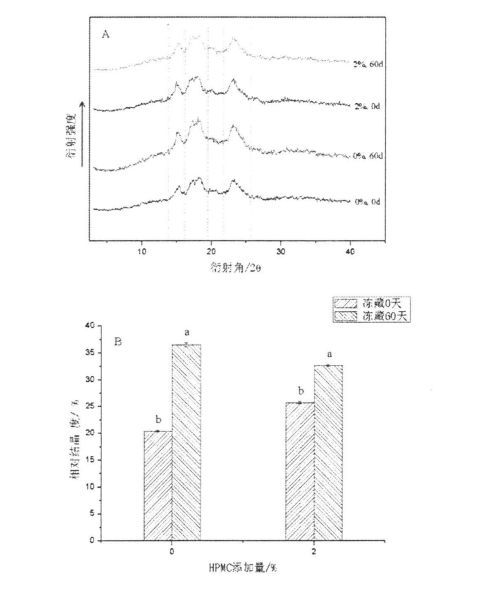
4. attēls.
Piezīme: a IS x. Rentgena difrakcijas shēma; B ir cietes relatīvais kristalitātes rezultāts;
5. nodaļa HPMC pievienošanas ietekme uz rauga izdzīvošanas ātrumu un fermentācijas aktivitāti sasaldētos uzglabāšanas apstākļos
5.1 Ievads
Raugam ir plašs pielietojums raudzētos miltu produktos (skābu iegūst ar dabisku fermentāciju, galvenokārt pienskābes baktērijām), tas mīklā var izmantot cietes hidrolizētu produktu - glikozi vai maltozi kā oglekļa avotu aerobos apstākļos, izmantojot vielas, izmantojot oglekļa dioksīdu un ūdeni pēc elpošanas. Izgatavotais oglekļa dioksīds var padarīt mīklu vaļīgu, porainu un apjomīgu. At the same time, the fermentation of yeast and its role as an edible strain can not only improve the nutritional value of the product, but also significantly improve the flavor characteristics of the product. Therefore, the survival rate and fermentation activity of yeast have an important impact on the quality of the final product (specific volume, texture, and flavor, etc.) [175].
In the case of frozen storage, yeast will be affected by environmental stress and affect its viability. Kad sasalšanas ātrums ir pārāk augsts, ūdens sistēmā ātri izkristalizēsies un palielinās rauga ārējo osmotisko spiedienu, tādējādi liekot šūnām zaudēt ūdeni; when the freezing rate is too high. Ja tas ir pārāk zems, ledus kristāli būs pārāk lieli, un raugs tiks saspiests un šūnas siena tiks sabojāta; both will reduce the survival rate of the yeast and its fermentation activity. In addition, many studies have found that after the yeast cells are ruptured due to freezing, they will release a reducing substance-reduced glutathione, which in turn reduces the disulfide bond to a sulfhydryl group, which will eventually destroy the network structure of gluten protein, resulting in a decrease in the quality of pasta products [176-177].
Materiāli un instrumenti
3M cietas plēves kolonijas ātrās skaitīšanas testa gabals
Sp. 754 modeļa UV spektrofotometrs
Ultra netīrā sterila operāciju tabula
Ražotājs
Angel Yeast Co., Ltd.
3M Amerikas korporācija
Šanhajas Spectrum Scientific Instrument Co., Ltd.
Shanghai Zhicheng Analytical Instrument Manufacturing Co., Ltd.
Chongqing Auto Optical Instrument Co., Ltd.
5.2.2 Eksperimentālā metode
Redzēt Meziani, et a1. (2012)'s experimental method [17 cited, with slight modifications. Weigh 5 g of frozen dough into a 50 mL colorimetric tube, press the dough to a uniform height of 1.5 cm at the bottom of the tube, then place it upright in a constant temperature and humidity box, and incubate for 1 h at 30 °C and 85% RH, after taking it out, measure the proofing height of the dough with a millimeter ruler (retain two digits after the decimal point). For samples with uneven upper ends after proofing, select 3 or 4 points at equal intervals to measure their corresponding heights (for example, each 900), and the measured height values were averaged. Each sample was paralleled three times.
Weigh 1 g of dough, add it to a test tube with 9 mL of sterile normal saline according to the requirements of the aseptic operation, shake it fully, record the concentration gradient as 101, and then dilute it into a series of concentration gradients until 10'1. No katras no iepriekšminētajām caurulēm uzzīmējiet 1 ml atšķaidīšanas, pievienojiet to 3M rauga ātrās skaita testa gabala centram (ar celma selektivitāti) un novietojiet iepriekš minēto testa gabalu 25 ° C inkubatorā atbilstoši darbības prasībām un kultūras apstākļiem, kas norādīti 3M. 5 D, izņemiet pēc kultūras beigām, vispirms novērojiet kolonijas morfoloģiju, lai noteiktu, vai tā atbilst rauga kolonijas īpašībām, un pēc tam skaitām un mikroskopiski pārbauda [179]. Katru paraugu atkārtoja trīs reizes.
The alloxan method was used to determine the glutathione content. Princips ir tāds, ka glutationa un alloksāna reakcijas rezultātam ir absorbcijas maksimums pie 305 NL. Specific determination method: pipette 5 mL of yeast solution into a 10 mL centrifuge tube, then centrifuge at 3000 rpm for 10 min, take 1 mL of supernatant into a 10 mL centrifuge tube, add 1 mL of 0.1 mol/mL to the tube L alloxan solution, mixed thoroughly, then add 0.2 M PBS (pH 7.5) and 1 mL of 0.1 M, NaOH solution to it, mix well, let stand for 6 min, and immediately add 1 M, NaOH The solution was 1 mL, and the absorbance at 305 nm was measured with a UV spectrophotometer after thorough mixing. Glutationa saturs tika aprēķināts no standarta līknes. Katrs paraugs tika paralēls trīs reizes.
5.2.2.5. Datu apstrāde
5.3.1
Mīklas pierādīšanas augstumu bieži ietekmē rauga fermentācijas gāzes ražošanas aktivitātes un mīklas tīkla struktūras stiprības kombinētā ietekme. Starp tiem rauga fermentācijas aktivitāte tieši ietekmēs tā spēju raudzēt un ražot gāzi, un rauga gāzes ražošanas daudzums nosaka raudzētu miltu produktu kvalitāti, ieskaitot īpašu skaļumu un tekstūru. Rauga fermentācijas aktivitāti galvenokārt ietekmē ārējie faktori (piemēram, barības vielu izmaiņas, piemēram, oglekļa un slāpekļa avoti, temperatūra, pH utt.) Un iekšējie faktori (augšanas cikls, metabolisma enzīmu sistēmu aktivitāte utt.).

5.1. Attēls. HPMC pievienošanas un saldētās uzglabāšanas ietekme uz mīklas pierādīšanas augstumu
Kā parādīts 5.1. Attēlā, kad 0 dienas sasaldēts, palielinoties HPMC daudzumam, mīklas pierādīšanas augstums palielinājās no 4,234-0,11 cm līdz 4,274 cm, nepievienojot HPMC. -0.12 cm (0.5% HPMC added), 4.314-0.19 cm (1% HPMC added), and 4.594-0.17 cm (2% HPMC added) This may be mainly due to HPMC Addition changes the properties of the dough network structure (see Chapter 2). Tomēr pēc 60 dienu sasaldēšanas mīklas pierādīšanas augstums samazinājās līdz dažāda pakāpei. Konkrēti, mīklas pierādīšanas augstums bez HPMC tika samazināts no 4,234-0,11 cm (sasalšana 0 dienas) līdz 3 .18+0,15 cm (saldēta krātuve 60 dienas); the dough added with 0.5% HPMC was reduced from 4.27+0.12 cm (frozen storage for 0 days) to 3.424-0.22 cm (frozen storage for 0 days). 60 days); the dough added with 1% HPMC decreased from 4.314-0.19 cm (frozen storage for 0 days) to 3.774-0.12 cm (frozen storage for 60 days); while the dough added with 2% HPMC woke up. The hair height was reduced from 4.594-0.17 cm (frozen storage for 0 days) to 4.09-±0.16 cm (frozen storage for 60 days). It can be seen that with the increase of the addition amount of HPMC, the degree of decrease in the proofing height of the dough gradually decreases. This shows that under the condition of frozen storage, HPMC can not only maintain the relative stability of the dough network structure, but also better protect the survival rate of yeast and its fermentation gas production activity, thereby reducing the quality deterioration of fermented noodles.
5.3.2. I-IPMC pievienošanas un sasalšanas laika ietekme uz rauga izdzīvošanas līmeni
In the case of frozen storage, since the frozen water in the dough system is converted into ice crystals, the osmotic pressure outside the yeast cells is increased, so that the protoplasts and cell structures of the yeast are under a certain degree of stress. When the temperature is lowered or kept at low temperature for a long time, a small amount of ice crystals will appear in the yeast cells, which will lead to the destruction of the cell structure of the yeast, the extravasation of the cell fluid, such as the release of the reducing substance - glutathione, or even complete death; Tajā pašā laikā tiks samazināts raugs, kas pakļauts vides stresam, pašas metabolisma aktivitāte, un tiks ražotas dažas sporas, kas samazinās rauga fermentācijas gāzes ražošanas aktivitāti.
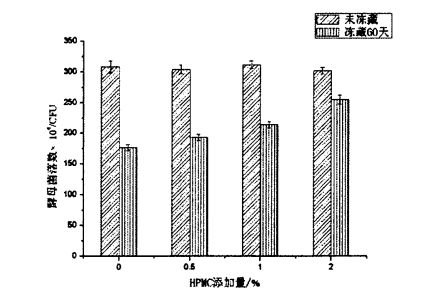
No 5.2. Attēla var redzēt, ka nav būtiskas atšķirības rauga koloniju skaitā paraugos ar atšķirīgu HPMC saturu, kas pievienots bez sasalšanas apstrādes. Tas ir līdzīgs rezultātam, kuru noteikusi Heitmann, Zannini, & Arendt (2015) [180]. However, after 60 days of freezing, the number of yeast colonies decreased significantly, from 3.08x106 CFU to 1.76x106 CFU (without adding HPMC); no 3.04x106 CFU līdz 193x106 CFU (pievienojot 0,5% HPMC); samazināts no 3,12x106 CFU līdz 2,14x106 CFU (pievienots 1% HPMC); samazināts no 3,02x106 CFU līdz 2,55x106 CFU (pievienots 2% HPMC). By comparison, it can be found that the freezing storage environment stress led to the decrease of the yeast colony number, but with the increase of HPMC addition, the degree of the decrease of the colony number decreased in turn. This indicates that HPMC can better protect yeast under freezing conditions. Aizsardzības mehānisms var būt tāds pats kā glicerīnam - parasti lietotu celma antifrīzu, galvenokārt kavējot ledus kristālu veidošanos un augšanu un samazinot zemas temperatūras vides stresu līdz raugam. Figure 5.3 is the photomicrograph taken from the 3M yeast rapid counting test piece after preparation and microscopic examination, which is in line with the external morphology of yeast.
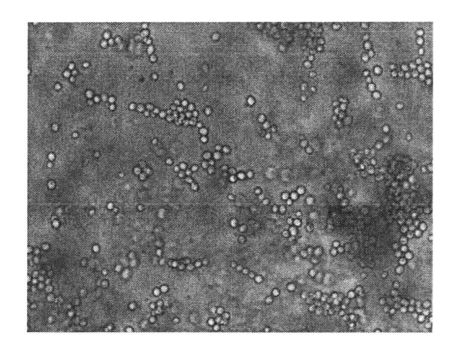
5.3. Raugu mikrogrāfs
5.3.3. HPMC pievienošanas un sasalšanas laika ietekme uz glutationa saturu mīklā
Glutathione is a tripeptide compound composed of glutamic acid, cysteine and glycine, and has two types: reduced and oxidized. When the yeast cell structure is destroyed and died, the permeability of the cells increases, and the intracellular glutathione is released to the outside of the cell, and it is reductive. It is particularly worth noting that reduced glutathione will reduce the disulfide bonds (-SS-) formed by the cross-linking of gluten proteins, breaking them to form free sulfhydryl groups (.SH), which in turn affects the dough network structure. stability and integrity, and ultimately lead to the deterioration of the quality of fermented flour products. Usually, under environmental stress (such as low temperature, high temperature, high osmotic pressure, etc.), yeast will reduce its own metabolic activity and increase its stress resistance, or produce spores at the same time. Kad vides apstākļi atkal ir piemēroti tā augšanai un reprodukcijai, tad atjaunojiet metabolismu un proliferācijas vitalitāti. However, some yeasts with poor stress resistance or strong metabolic activity will still die if they are kept in a frozen storage environment for a long time.
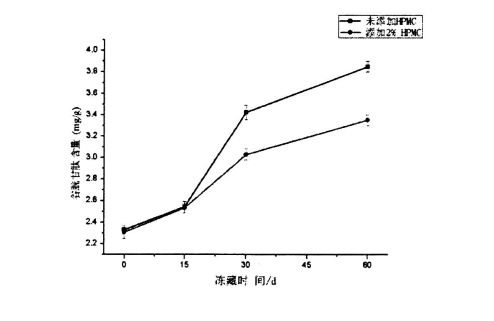
As shown in Figure 5.4, the glutathione content increased regardless of whether HPMC was added or not, and there was no significant difference between the different addition amounts. Tas var būt tāpēc, ka daži no aktīvajiem sausajam raugam, ko mīklai izmanto, ir slikta izturība pret stresu un toleranci. Under the condition of low temperature freezing, the cells die, and then glutathione is released, which is only related to the characteristics of the yeast itself. Tas ir saistīts ar ārējo vidi, bet tam nav nekā kopīga ar pievienoto HPMC daudzumu. Tāpēc glutationa saturs palielinājās 15 dienu laikā pēc sasalšanas, un starp abiem nebija būtiskas atšķirības. Tomēr, turpinot sasalšanas laiku, glutationa satura palielināšanās samazinājās, palielinoties HPMC pievienošanai, un baktēriju šķīduma glutationa saturs bez HPMC tika palielināts no 2,329a: 0,040 mg/ g (saldētās krātuves 0 dienas) palielinājās līdz 3,8514-0,051 mg/ g (saldētām krātuvēm) 60 dienas); while the yeast liquid added 2% HPMC, its glutathione content increased from 2.307+0 .058 mg/g (frozen storage for 0 days) rose to 3.351+0.051 mg/g (frozen storage for 60 days). This further indicated that HPMC could better protect yeast cells and reduce the death of yeast, thereby reducing the content of glutathione released to the outside of the cell. This is mainly because HPMC can reduce the number of ice crystals, thereby effectively reducing the stress of ice crystals to yeast and inhibiting the increase of extracellular release of glutathione.
Yeast is an indispensable and important component in fermented flour products, and its fermentation activity will directly affect the quality of the final product. In this experiment, the protective effect of HPMC on yeast in frozen dough system was evaluated by studying the effect of different HPMC additions on yeast fermentation activity, yeast survival number, and extracellular glutathione content in frozen dough. Through experiments, it was found that the addition of HPMC can better maintain the fermentation activity of the yeast, and reduce the degree of decline in the proofing height of the dough after 60 days of freezing, thus providing a guarantee for the specific volume of the final product; Turklāt tika kavēts HPMC pievienošana rauga izdzīvošanas skaita samazināšanai un samazināts samazināta glutationa satura līmenis tika samazināts, tādējādi mazinot glutationa bojājumus mīklas tīkla struktūrā. This suggests that HPMC can protect yeast by inhibiting the formation and growth of ice crystals.
Pasta laiks: oktobris-08-2022







